We are an independent publisher. Our reporters create honest, accurate, and objective content to help you make decisions. To support our work, we are paid for providing advertising services. Many, but not all, of the offers and clickable hyperlinks (such as a “Next” button) that appear on this site are from companies that compensate us. The compensation we receive and other factors, such as your location, may impact what ads and links appear on our site, and how, where, and in what order ads and links appear. While we strive to provide a wide range of offers, our site does not include information about every product or service that may be available to you. We strive to keep our information accurate and up-to-date, but some information may not be current. So, your actual offer terms from an advertiser may be different than the offer terms on this site. And the advertised offers may be subject to additional terms and conditions of the advertiser. All information is presented without any warranty or guarantee to you.
This page may include: credit card ads that we may be paid for (“advertiser listing”); and general information about credit card products (“editorial content”). Many, but not all, of the offers and clickable hyperlinks (such as a “Apply Now” button or “Learn More” button) that appear on this site are from companies that compensate us. When you click on that hyperlink or button, you may be directed to the credit card issuer’s website where you can review the terms and conditions for your selected offer. Each advertiser is responsible for the accuracy and availability of its ad offer details, but we attempt to verify those offer details. We have partnerships with advertisers such as Brex, Capital One, Chase, Citi, Wells Fargo and Discover. We also include editorial content to educate consumers about financial products and services. Some of that content may also contain ads, including links to advertisers’ sites, and we may be paid on those ads or links.
For more information, please see How we make money .

What to know about going through TSA with baby food
Signing up for credit cards through partner links earns us a commission. Terms apply to the offers listed on this page. Here’s our full advertising policy: How we make money .
Bringing your little one along for a trip is a great way to bond and make lifelong family memories. Flying with your baby doesn’t need to be intimidating or stressful, and neither does getting their food through TSA. Your baby’s food is the most important thing you’ll travel with, and you’re permitted to bring frozen and bottled breast milk, as well as juices and formula for your baby on planes. All you need to do is plan ahead and budget more time at the airport!
TSA policies regarding baby food
TSA allows baby food in your carry-on bag — don’t leave your child’s food in your checked bag and risk it all getting lost in transit! Pack your formula, breast milk or juice in TSA pouches . When you arrive at TSA with your carry-on full of baby food, be sure to inform the TSA agent that you are traveling with the food before you begin your screening process. TSA will ask you to take these items out of your bag and will screen them through a separate process.
All formula, breast milk and juice will go through an X-ray screening process, the same one as your checked bag. TSA may need to test your liquids for explosives or concealed prohibited items and may request you to open them. If you don’t want your baby food open, you can deny this request — additional steps will be taken by TSA to ensure they’re safe for travel without opening.
Formula, breast milk and juices are an exemption under the 3-1-1 liquids rule for flying. This means that you can bring them in quantities greater than 3.4 oz, which is not the case for most other liquids going through TSA . Additionally, TSA allows ice packs and freezer packs for the purpose of freezing baby food — you can line a cooler bag with these to keep your baby food fresh! If you’re flying with a toddler , you can bring gel or liquid-filled teethers, canned, jarred, and processed food along in carry-on baggage.
Tips for getting baby food through TSA without hassle
Make traveling with baby food quick and easy!
Determine how much food you’ll need to travel with in advance
No one knows your baby better than you — you know when your baby needs to eat! Before your trip, think about how long you’ll be gone, how many times and the amount your baby eats per day. Plan to bring at least this much food for your trip!
For parents that pump, consider pre-pumping and freezing some breast milk, and bring your pump with you to supplement the rest. For parents using formula, pre-package your baby’s food in TSA baby food pouches and store them away for the trip.
Pack your baby food well & keep it with you
TSA allows ice packs, freezer packs and the like for baby food — take advantage of this! Make sure you’re packing your cooler bag tightly and putting as many of these as you need inside to keep your food frozen.
Since baby food is allowed in your carry-on bag, be sure to keep your eye on it at all times. Don’t let it leave your sight when it’s going through TSA or in the airport in general — your baby needs it and unless you’re on a very short flight, they’ll probably need to eat on the plane.
Insider Tip: Some airlines, like Southwest , allow babies and young toddlers to travel for free! Always be sure to check if there’s a child fare when booking your flight.
Give yourself extra time to go through security
Because of all the policies TSA has surrounding baby food, it’s important to give yourself extra time when traveling with it. You might need to jump through a few hoops to get it past TSA, and all food needs to be separately screened. This applies especially if you plan to bring a large amount of baby food on the plane. It’s better to be safe than sorry in this case — make sure you get your baby food through security and make your flight with plenty of time to spare!
FAQ for traveling with baby food
Can you bring squeezable baby food on a plane.
Yes! Squeezable pouches, jars or cans of baby food are all allowed on the plane and adhere to the same rules as breast milk, juices and formula. You can even bring gel or liquid-filled teething rings and toys for your little ones on the plane!
How much baby food can you take on a plane?
TSA allows baby food in “reasonable quantities” on planes. Basically, this means there is no strict cut-off for how much food you can bring on the plane. Bring only the amount of baby food your baby needs for the trip and you shouldn’t have any problems getting through security.
Can I bring water for baby formula on a plane?
Yes! Again, water for baby formula and babies is permitted by TSA in “reasonable quantities” in carry-on bags. The water for your baby formula will have to undergo the same screening process as the other foods you bring for your baby, but you shouldn’t have any trouble getting it onto the plane.
Bottom line
Whether you’re solo parent traveling or tag-teaming it with little ones, getting your baby’s food through TSA can be a stress-free and hassle-free process. TSA allows formula, breast milk and juices in quantities that exceed 3.4oz, which is the typical rule, and you’ll be able to bring stocked cooler bags as well if needed. Be sure to give yourself plenty of time to get through security and have the food screened properly, plus keep it in your carry-on bag to make sure you have it with you whenever your baby needs it. After that, all that’s left to do is enjoy your trip with a happy and full baby!
Alexandra Maloney
Contributor
Alexandra Maloney is a contributor for Million Mile Secrets where she covers points and miles, credit cards, airlines, hotels, and general travel. She's worked as a writing consultant for the University of Richmond and is a features writer for The Collegian UR.
More Topics
Family Travel,
General Travel
Join the Discussion!
You May Also Like
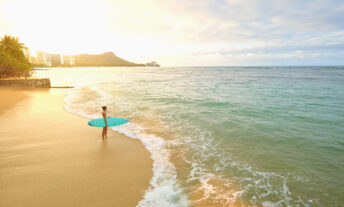
BonusTracker: Best credit card bonus offers
June 14, 2021 4
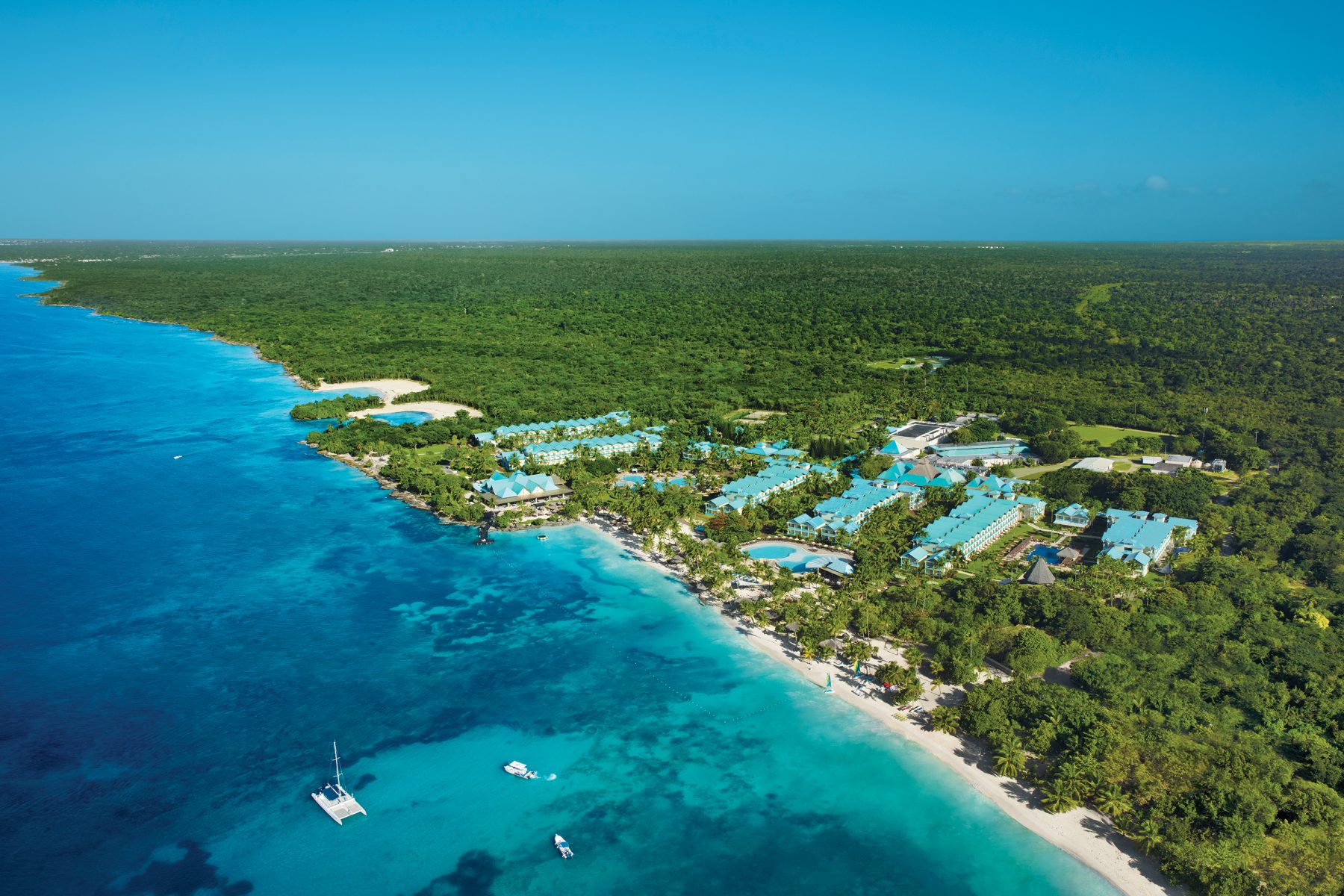
Best Hilton credit cards: Improved weekend night certificates, earning rates and more
June 12, 2021 2
Our Favorite Partner Cards
Popular posts.


An official website of the United States government
Here’s how you know
Official websites use .gov A .gov website belongs to an official government organization in the United States.
Secure .gov websites use HTTPS A lock ( Lock A locked padlock ) or https:// means you’ve safely connected to the .gov website. Share sensitive information only on official, secure websites.
Traveling with Children
All passengers are required to undergo screening. However, TSA has developed modified screening procedures for children who appear to be 12 years old and younger. TSA officers will consult parents or the traveling guardian about the child’s screening.
TSA standard screening procedures apply for children 13 years and older. Carry-on property of all passengers, regardless of age, must be screened. All passengers who alarm will undergo additional screening.
Children with Medical Conditions, Disabilities, or Mobility Aids
Inform the TSA officer if the child has a disability, medical condition or medical device.
Let the TSA officer know if your child is able to walk through the metal detector or needs to be carried through the metal detector by a parent/guardian. You may carry your child through the WTMD. The TSA officer will not remove your child from their mobility aid, wheelchair or scooter.
Request Assistance
TSA Cares provides information to passengers with disabilities, medical conditions and those that need additional assistance to better prepare for the security screening process. Call TSA Cares 72 hours prior to traveling with questions about screening policies, procedures and what to expect at the security checkpoint. You may also call to request assistance at the checkpoint.
Liquid Formula, Breast Milk, Toddler Drinks, and Baby/Toddler food (to include puree pouches)
Formula, breast milk, toddler drinks and baby/toddler food (to include puree pouches) in quantities greater than 3.4 ounces or 100 milliliters are allowed in carry-on baggage and do not need to fit within a quart-sized bag. Formula, breast milk, toddler drinks and baby/toddler food (to include puree pouches) are considered medically necessary liquids. This also applies to breast milk and formula cooling accessories, such as ice packs, freezer packs and gel packs (regardless of presence of breast milk). Your child or infant does not need to be present or traveling with you to bring breast milk, formula and/or related supplies.
Inform the TSA officer at the beginning of the screening process that you are carrying formula, breast milk, toddler drinks and baby/toddler food (to include puree pouches) in excess of 3.4 ounces. Remove these items from your carry-on bag to be screened separately from your other belongings. TSA officers may need to test the liquids for explosives or concealed prohibited items.
It’s helpful to the officers when formula and breast milk are in clear, translucent bottles and not plastic bags or pouches. Liquids in plastic bags or pouches may not be able to be screened by Bottle Liquid Scanners, and you may be asked to open them (if feasible) for alternate screening such as Explosive Trace Detection and Vapor Analysis for the presence of liquid explosives. Screening will never include placing anything into the medically necessary liquid.
TSA X-ray machines are not harmful to food or medicines. However, if you do not want the formula, breast milk, toddler drinks, and baby/toddler food (to include puree pouches) to be X-rayed or opened, please inform the TSA officer. Additional steps will be taken to resolve alarms. You or the traveling guardian will undergo additional screening procedures, to include Advanced Imaging Technology screening and additional/enhanced screening of other carry-on property.
Ice packs, freezer packs, frozen gel packs and other accessories required to cool formula, breast milk, toddler drinks and baby/toddler food (to include puree pouches) – regardless of the presence of breast milk – are also allowed in carry-ons, along with liquid-filled teethers. If these items are partially frozen or slushy, they are subject to the same screening as described above.
Passengers requiring special accommodations or concerned about the security screening process at the airport may request assistance by contacting TSA Cares or by phone at (855) 787-2227.
Screening of Children’s Items
- Place all carry-on baggage such as children's toys, bags and blankets on the X-ray belt for screening.
- Strollers, umbrella-strollers, baby carriers, car and booster seats and backpacks must be screened by X-ray.
- Place items in the stroller pockets or baskets, in a carry-on bag or on the X-ray belt for screening.
- Equipment that does not fit through the X-ray machine will undergo a visual/physical inspection by TSA officers.
Screening Technology
Walk-Through Metal Detector
Children able to walk through the metal detector without assistance may do so separately from their parent or guardian. If they alarm, children are allowed multiple passes through screening technologies and may undergo other procedures to resolve the alarm to reduce the need for a pat-down. Infants and small children may be carried through the metal detector. Should the alarm sound, additional screening is required.
Advanced Imaging Technology
If your child is able to remain standing in the required position for 5 seconds, he or she may be screened through the advanced imaging technology. If a child 12 and under goes through the machine and alarms, they have an opportunity to go through again or the TSA officer may use other procedures to resolve the alarm to reduce the need for a pat-down.
You may not be screened by this technology when carrying an infant or child.
Screening your Child
- Children 12 and under can leave their shoes, light jackets and headwear on during screening. For AIT screening, light jackets must be removed and placed on the X-ray belt.
- Children will not be separated from their parent/guardian.
- Remove infants and children from strollers and car seats and carry them in arms through the walk-through metal detector.
- Infants may be carried in a sling/carrier (to include lap baby) through the walk-through metal detector or when being screened in a wheelchair, but may be subject to additional screening
- Modified screening procedures are in place to reduce the likelihood of a pat-down.
Luggage shop by size
How To Travel With Baby Formula And Food
Travelpro Travel Expert Editor
Tips & Tricks
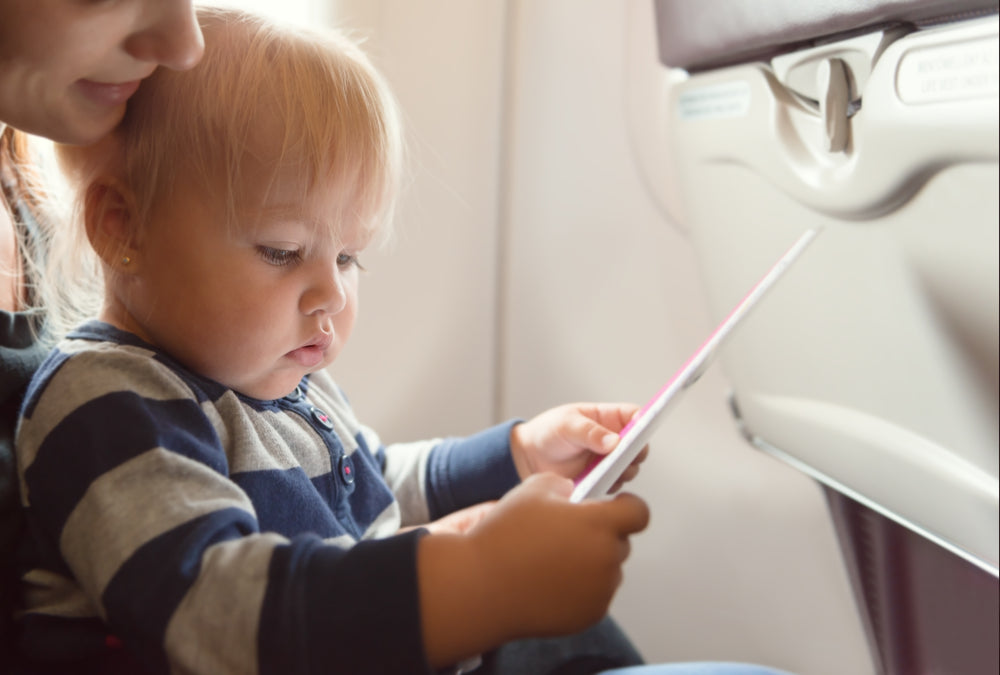
Planning a family trip is exciting, but packing for it can be overwhelming, especially if you plan to fly with your little ones. You can travel with milk, formula, or baby food no matter where you are. When you must pass through airport security and have enough supplies on hand for days, handling these items requires some simple preparation.
Before packing your bags, here are a few tips on traveling with baby formula and food so that you – and the whole family – stay happy.
Can you bring baby formula on a plane
The TSA classifies baby formula as medically necessary, so you can pack as much baby formula as you need for the trip without being limited to the 3.4-ounce rule that applies to other liquids. When you go through security screening, inform airport security of the amount of baby formula you’re carrying. Remove the formula from your carry-on so the agent can screen it separately. TSA officers may test the liquid to confirm it is baby formula and not a prohibited liquid.
Can you bring powdered formula on a plane?
You can pack unmixed baby formula in your carry-on. As with premixed powder, inform the TSA agent you have the baby formula during screening. Ideally, keep the formula in its original packaging. Security may test a small portion of the formula for prohibited substances but will not add anything to the formula package.
Breast or Store-Bought Milk
The rules for breast milk are the same as for baby formula. You can bring as much breast milk as you need for the trip in your carry-on, preferably stored in transparent bottles. The same rules apply if you’re wondering how to travel with milk for a 1-year-old. Milk for older children will be subject to the same 3-1-1 rules as other liquids.
Can you bring baby food on a plane
You can bring baby and toddler food on a plane in quantities greater than 3.4 ounces, including jars and baby food pouches of fruits, vegetables, and meat/poultry purees. Store the food in well-sealed containers separate from the rest of your personal belongings.
Can you bring homemade baby food on a plane?
Homemade baby food is allowed in carry-on bags but may be subject to additional screening by TSA agents. Label all homemade baby food before packing, and have it stored in an accessible location in your carry-on bag.
How to keep baby formula and food safe on board
Once you have figured out just how much baby formula powder/ breastmilk and food you should pack, you need to plan how to keep the food safe. Some trips can be long and involve many more hours than just your flight time. How can you ensure your baby’s food stays fresh?
Here are a few things you can do to ensure that your baby's food and formula are safe during travel:
- A travel cooler bag is your best bet for day trips to week-long adventures. Some are made for wet and dry foods and can be used to keep food warm or cold.
- Check baby food and formula containers for expiration and refrigeration requirements
- Use ice packs to keep food and formula cold when needed.
- Avoid giving your baby food from open containers that have been sitting out at room temperature for more than two hours.
- Do not heat baby food or formula using the airplane's microwave.
Being prepared by following these few guidelines will give you peace of mind for a safe and healthy trip. Check out more of our family travel blogs for other helpful tips and tricks on kid- and baby-friendly travel.
Share on Facebook
Tweet on Twitter
Pin on Pinterest
You might also enjoy
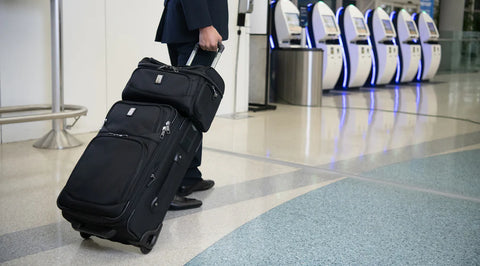
Tips & Tricks For Navigating an Airport Like a Pro
Travelpro Travel Expert Editor The Travelpro® Blog
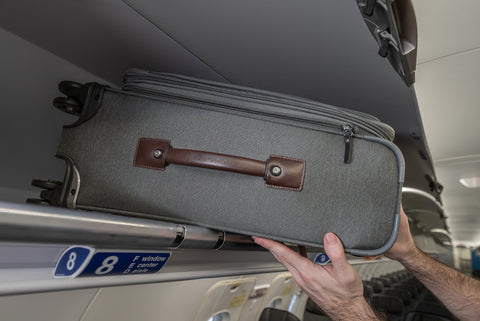
How to Board a Plane
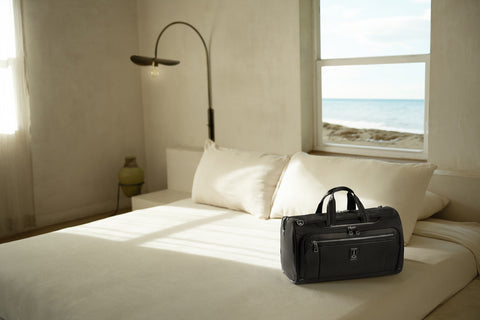
Duffle Bags as Carry-On: Everything You Need to Know
How to pack — and prepare — for travel with a baby

About to take your first trip with a new baby ? Or maybe this isn't your first time traveling with your little one , but you'd like to pack more efficiently this time around.
It can be hard to know how to prepare and pack when you have a baby in tow. Babies often change so quickly that anticipating their needs can be complicated — especially if you're planning a longer trip.
In addition to typical packing concerns, such as the weather in your destination or luggage size restrictions, it's not always clear what you can carry on or must check when it comes to your infant. Here's our advice to help you prepare, pack and travel better with your baby.
Sign up to receive the daily TPG newsletter for more travel advice .
Choose accommodations wisely (and pack accordingly)
If you're traveling by car, you can easily pack a travel crib and other larger baby items.
However, if you're flying, choosing the right accommodation is the key to packing lighter, which is the goal. Toting around an infant is strain enough — staying somewhere that provides baby items means you can leave the extras at home.
Check with your hotel to see if it offers cribs or other baby items, as well as if it provides laundry services or facilities where you can do your own. Some hotels will even provide an extra fridge for milk storage upon request.
Often, a home rental might be a better choice than a hotel, assuming you pick the right one. Airbnb allows you to filter properties by items such as "crib" and "high chair." You can also message hosts to see if they have any other baby-friendly items available.
For example, I recently filtered an Airbnb search in Punta Cana in the Dominican Republic to show only rentals that included a crib, high chair, washer and dryer. I ended up picking a rental that included not only the aforementioned items, but also a bottle sterilizer, bottle warmer and a few other infant-friendly items, which allowed me to pack less.
Some rentals I've stayed in even provided baby toys, books and cutlery. The key is communication. Don't hesitate to message and confirm the equipment again with hosts as you pack. You can also request or confirm that everything will be set up and ready for the baby upon your arrival.
Access to a washer and dryer is important since babies tend to have accidents or leaky diapers. Being able to do laundry also lets you pack fewer clothes. Also, if your rental is not a stand-alone house or a unit on the first floor, check that there is an elevator. A five-floor walk-up in a multi-unit building can be difficult with a stroller, shopping bags and baby in your arms.
Call your airline to understand the regulations
Depending on your airline, fare class and destination, you may have to adhere to different rules when it comes to traveling with an infant.
Those regulations can also vary depending on whether you've purchased a lap ticket versus a separate seat for your baby. In almost all cases, airlines allow travelers with an infant to gate-check a stroller or buggy, and some may also allow a car seat. Check with your airline ahead of time to understand baggage rules for your little one to avoid getting caught off guard at the airport or paying extra, especially when flying low-cost carriers like Ryanair or Spirit .
Flying with an infant in a car seat and hoping to bring it on the plane? Make sure it's approved for air travel. You may also want to request a bassinet for your baby, if the aircraft you're flying offers one (check the weight limits, however). Ask for an aisle seat, as it makes standing up with your baby much easier.
Invest in travel-friendly baby items
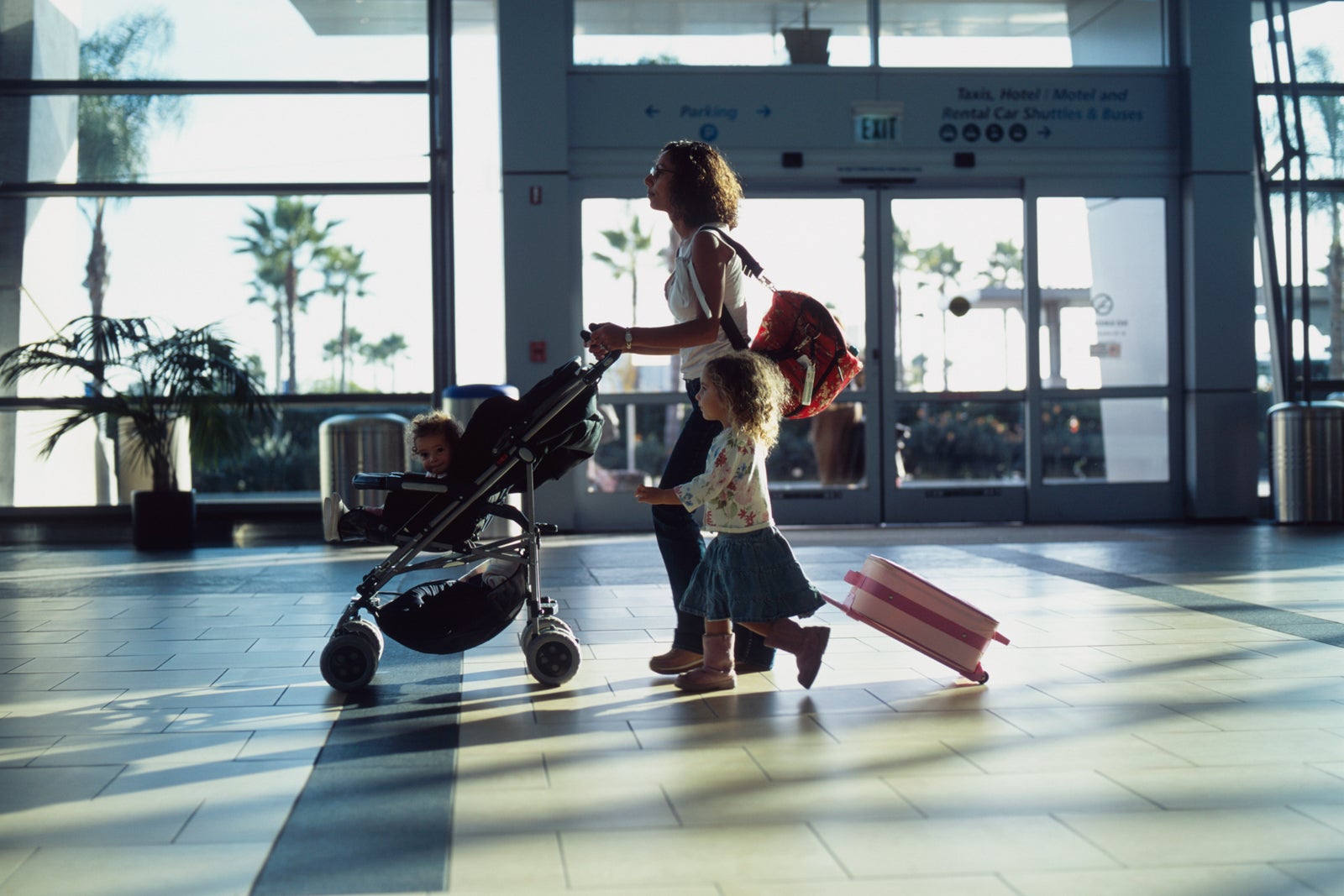
Having a dedicated (foldable) travel stroller will be useful beyond air travel. It's the perfect item to have when exploring a new city. Other key travel baby items to consider taking along are:
- Travel diaper backpack.
- Portable changing pad.
- Travel car seat.
- A bag for a car seat or stroller so these items aren't damaged if checked.
- Portable baby monitor.
- Baby carrier or wrap.
- Swaddle or baby blankets.
- Inflatable bathtub .
- Pack 'n Play or travel crib.
- Travel neck pillow (use it while feeding your baby).
- Baby chair strap.
- Disposable bottle liners.
- Disposable bibs.
- Portable blackout shades for travel cribs or strollers.
Purchase (or preorder) diapers, formula and more at your destination
Depending on how long your trip is and where you're headed, calculate (and it's always best to over-calculate) how many diapers you'll need for the trip.
If your baby uses a specific formula or baby food, make sure you know where to buy it at your destination. Amazon and other delivery services can be useful for ordering these items -- and remember, these services are available internationally, too. You can also compare ingredients to see if you can get a similar formula or food at your destination, so you won't have to load up your suitcase with diapers or formula.
Don't worry if you forget baby socks or another basic item. Babies live all over the world, so you'll likely find many basic items available for purchase wherever you are. If your baby requires something specific, though, pack it just in case.
There are also companies that rent baby gear in many destinations around the world. Research ahead of time to find out exactly where and how to obtain these necessary items, especially when traveling abroad .
Carry on the essentials (and extras)
Always pack your baby's key essentials in your carry-on . This includes comfort items like their favorite toy or pacifier, and extra clothes for both your baby and you (in case their wardrobe disaster becomes yours, as well). You should also pack enough food, diapers and other key items to last you through the trip, plus more for any possible delays and/or cancelations.
Here's a list of items you may want to keep in your carry-on bag :
- Extra clothing for you and your baby.
- Layers of clothing or blankets (plane temperatures are often extreme).
- Pacifier and clip (and backup).
- Comfort toy(s) or blanket.
- Extra diapers.
- Breast pump.
- Snacks (for you and your baby).
- Baby wipes.
- Sanitizing wipes.
- Extra bibs.
- Ziploc bags for stowing soiled clothing (or a reusable, waterproof bag).
- Baby Tylenol or any infant medications.
- A basic first aid kit.
- Small toy(s).
The rest of your baby's items, like additional clothing, blankets and more, can go in your checked bag. If you're checking more than one bag, split your baby's items among different checked suitcases. That way you'll be covered if the airline loses one of your suitcases.
Know the security regulations and have a backup plan
On a recent call to Iberia Airlines , I was told I could bring "reasonable quantities" of formula and breast milk through security. However, the representative also told me that in some cases during security checks, certain agents might not allow me to pass these items through security at the Madrid-Barajas Airport (MAD) . What?
Not all security checks, Transportation Security Administration agents or customs agents are alike, and each country, airport or airline may have specific regulations. Call ahead of time and prepare for things to not go as planned. If you do use formula, take your bottles already mixed, but also bring extra powder in case you need to prepare new bottles on board.
If you're pumping, it might also be a good idea to bring both a hand pump and an electric pump in case you have limited access to electricity or encounter issues with electrical outlets or voltage when traveling internationally.
Arriving at the airport early is always a good idea, because you may not breeze through security as you might have in your pre-baby days. Everything takes longer with an infant, so having that extra time can ensure a low stress travel experience. Take advantage and board the airplane first to give you extra time to get settled. If your airport has a family security line, use it.
Make sure you understand any remaining COVID-19 regulations
As mask rules and COVID-19 testing, entry and vaccine regulations continue to evolve in countries around the world, stay on top of exactly what you need to know and bring for your baby to get to your destination (and back home again). It's important to understand whether you'll need masks for your 2-year-old or need to show proof of a negative COVID-19 tests upon arrival at your destination or re-entry into the U.S. when traveling abroad.
Remember that airline staff members also struggle to keep track of ever-changing rules, so if you know something has recently changed or a rule seems specific, make sure to bring along proof of this information and whatever documentation you need in case you have trouble when boarding.
Photocopy important documents and always have extras. I loathe having to take paper documents along when traveling. However, having them may mean the difference between getting through customs, being able to board or being stranded at the airport. This is especially true if your phone battery dies or you're left without service for any reason. While being denied boarding is always dramatic, it's even worse with a baby in tow.
Download the right apps
Mobile phone apps can help you anticipate what you need, as well as keep your baby (and yourself) comfortable during travel.
A white noise app is key for better sleep for your baby — and therefore better sleep for parents — and allows you to leave a white noise machine home. Nightlight apps are also helpful during travel.
You can also connect most modern baby monitors to your phone and use an app to access the video of your baby so you won't need a separate viewing device.
Parents may find an app to track sleeping and feeding especially helpful during travel, particularly when switching time zones. A general packing app could help you keep track of what you need to bring for your infant, as well as the entire family. Make sure these apps are accessible offline if you need them while flying.
Don't forget their passport
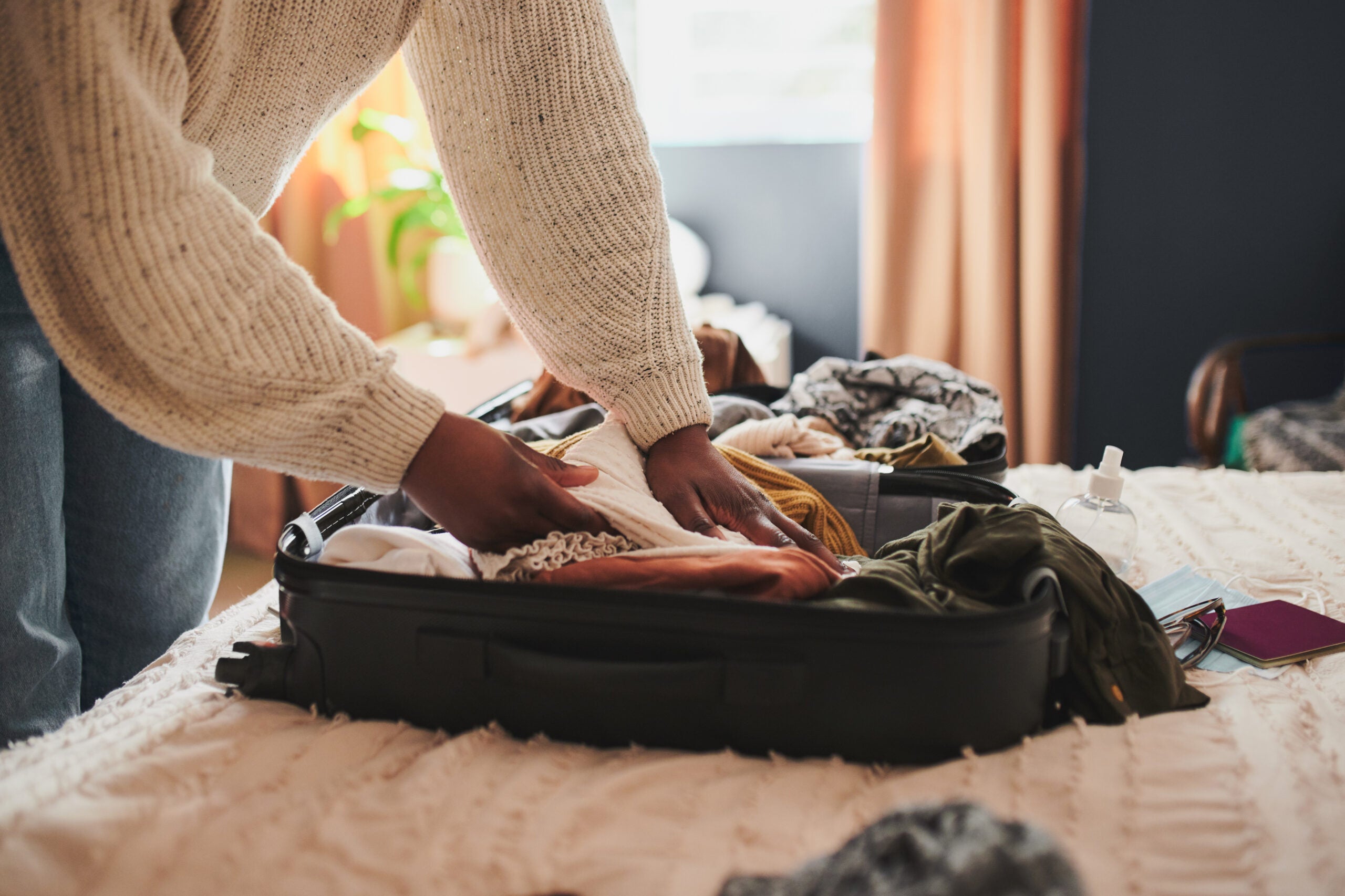
This one is obvious, but you'd be surprised. Don't forget your baby's passport when traveling.
Look into identity and consent documents, as each country has its own requirements, especially if your partner isn't with you. If you have any older children, make sure to check that their passports are valid, as children's U.S. passports expire in just five years.
Traveling with a baby might seem like a lot. However, once you get the hang of it, packing, prepping and traveling with your infant becomes second nature. Ask for help when you need it and accept help when offered.
And when things don't go quite right, stay relaxed (remember, baby can feel your moods) — you'll figure it out. While it may seem tragic in the moment (like that major diaper blowout on board a plane), it will be an epic story to share one day.
Bottom line
When in doubt, bring enough baby supplies for a few extra days or a flight delay, but don't overpack. Make sure to be clear on any and all regulations that will cover your travel, from having the right documents to understanding what baby items you can bring through airport security . With these tips, packing and traveling will be a more enjoyable experience for the entire family .
37 Best Travel Tips for Traveling With an Infant, Older Baby, or Toddler

Family travel is exciting for you and your kids and can create special memories that last a lifetime, whether you’re off on an adventure abroad or simply going to visit Grandma. But traveling with an infant, older baby, or toddler requires a little extra preparation to ensure a safe and comfortable trip. We’ve got the answers to common questions surrounding baby travel—short and long—plus a list of all the essentials and 37 tips for traveling with the little ones!
How Soon Can You Travel With a Newborn Baby?
When is it safe to travel with a newborn? It’s always wise to check with your healthcare provider before traveling with an infant. Your provider will likely offer specific guidance on whether you should or shouldn’t travel with your little newborn, depending on your little’s one's age and health status, as well as more general advice on when you can travel with a baby or older child. Whenever you do end up traveling with your little one, keep some safety precautions in mind. Your child is still developing their immune system, so it’s important to take protective measures, especially when flying or in crowded locations, such as
frequently washing hands
using hand sanitizer
avoiding visibly ill travelers.
Besides these basic safety precautions, keep reading for more tips on traveling with infants, plus older babies and toddlers, which include additional measures that will help keep your little one healthy, safe, and comfortable.
37 Tips for Traveling With an Infant, Older Baby, or Toddler
There are many ways you can help keep your infant, older baby, or toddler safe while traveling, and ensure that the trip is comfortable for all involved. It’s best to always consult with your child’s healthcare provider before traveling, especially with newborns or infants. Younger babies are more vulnerable than older babies and toddlers, so consider the provider’s advice and tips for traveling with an infant. Knowing how to travel with an infant isn’t much different from knowing how to travel with an older baby or toddler, but age can impact strategy. For example, traveling with a toddler opens up more opportunities for activities on your trip! You’ll probably notice that traveling with a 2-year-old is a lot more interactive than when your little one was just 3 or 6 months old. To cover all the bases, we’ve included 37 tips for traveling with babies of any age, but some apply more to younger babies, like infants and newborns, whereas others are more geared toward older babies and toddlers. However, all are worth considering when traveling with kids of any age and whether you’re flying to Paris or hopping in the car for a day trip.
1. Update Immunizations
Before you travel, including by car, on an airplane, or anywhere abroad, ensure your baby has had all the necessary immunizations. Following an immunization schedule is key to keeping your little one healthy throughout their life and, of course, when traveling. If you plan to travel abroad, be aware that some countries require additional vaccinations. You’ll want to consult your child’s healthcare provider for specific advice before planning any overseas trips, and you can contact the U.S. State Department for general information. As children will need immunizations and boosters throughout their early years, this tip also applies to travel with infants, older babies, and toddlers.
2. Consult Your Child’s Healthcare Provider
Remember that your baby’s healthcare provider is your ally and a great source of information. Don’t hesitate to be in touch if you have any questions about traveling with an infant or how to best travel with a baby of any age. If you’re thinking of traveling with a newborn, the provider may suggest waiting in some cases, such as if your little one has an underlying health condition or was born prematurely.
3. Collect Medications and Important Documents
Before setting off on your adventure, remember to pack any medication your child will need while away from home. You can also purchase a sturdy folder to keep any important documents, such as your baby’s vaccination record, copies of recent medical reports, passport, etc. When traveling with an infant, older baby, or toddler, it’s always best to err on the side of caution and bring everything you might need!
4. Do Some Research
One of the best tips for traveling with newborns or older babies and toddlers is to hunt for and gather relevant information ahead of time. Besides things like looking up vaccination requirements, you can also research details about accommodations and activities. Some hotels offer amenities that may come in handy when traveling. For example, if you’re breastfeeding your baby , you might want a refrigerator in your hotel room to store extra milk.
5. Allow Extra Time
Always remember that traveling with an infant or baby of any age means everything will take a little more time (or sometimes a lot more time!). Be sure to start early and allow extra time when packing the car or getting to the airport, going through security, checking into your accommodation, eating out, etc. This additional time makes for a smooth trip and also helps keep stress to a minimum.
6. Bring Those Baby Essentials
Although your research may reveal that hotels or accommodations offer some basic baby necessities, it’s best to bring as much as you can with you. For example, if a hotel offers cribs, unless you can guarantee that their baby cribs are up to date on safety requirements, it’s better to bring your own travel crib if you’re able to do so. Other travel essentials for your baby include bottles, bibs, diapers and wipes , pacifiers, etc. Keep these in a separate diaper bag for easy access! Our baby travel checklist below includes all these items and more.
7. Don’t Forget Favorite Toys or Blankets
Your little one is still getting used to the world around them, so bring some reminders of home to soothe any discomfort when in unfamiliar places. A favorite plush toy, a familiar rattle, or a blanket with home scents can do wonders in keeping your babies and toddlers comfortable when traveling, so be sure not to leave Mr. Rabbit (or any other "lovey") at home!
8. Double Check Car Seats
Whether traveling with your infant, older baby, or toddler by car or plane, double-check any car seats you use for safety . Look up the expiration date to make sure the seat hasn’t expired, and ensure that it’s properly installed.
9. Keep Feedings and Sleep Schedules Consistent
When traveling with babies, especially newborns and infants, it’s best to keep feeding and sleep schedules consistent, even when crossing into other time zones. It’s hard for children to adjust to new routines, and a little consistency will do wonders. If you’re moving across several time zones and it’s impossible to stick to the same feeding times, try to adjust your schedule gradually. However, what’s most important is feeding your baby when they’re hungry, regardless of the hour, and giving yourself some extra grace.
10. Bring a First-Aid Kit
In addition to all your essential must-have items, it’s also helpful to have your baby’s first-aid kit with you when traveling. You can keep one in the car, diaper bag, or your little baby’s overnight bag. Do you have all the baby necessities in your diaper bag? Take our quiz below to find out!
11. Wash Hands Frequently
Although briefly mentioned above, this is one of the most important tips for traveling with an infant or child of any age, and it deserves a friendly reminder! Because your little one is still building their body’s natural immune defenses, they’re more susceptible to catching colds, flu, or other infections. And because you’ll be carrying your newborn while traveling or holding your baby’s hand, it’s best for you to wash your hands frequently and use hand sanitizer.
12. Stay Hydrated
Traveling in general, but especially traveling by plane, is dehydrating to the body. Staying hydrated yourself means staying healthy and alert for your child. To keep your newborn hydrated, you’ll want to feed them more often (if needed), and older babies and toddlers will need sips of water throughout the day. Hydration is also very important if your little one has diarrhea while traveling, which is common.
13. Bring Disposable or Hybrid Diapers
When you’re traveling, nothing beats the convenience of disposable diapers. Another option is a hybrid system, like Pampers Pure Hybrid Starter Kit, which uses reusable covers and disposable inserts to cut down on waste.
14. Provide Entertainment
You may find that your newborn sleeps through much of the trip, but that probably won’t be the case for an active older baby or toddler! When traveling with a baby who’s a bit older and more alert, it helps to provide some form of entertainment, whether in the car, on the train, or on an airplane. A soft toy or a picture book work well.
15. Bring Food and Snacks
You don’t have to travel with a baby to know that meals and snacks are an important part of any outing! You’ll need to breastfeed or bring formula, of course, supplemented by solid foods once your little one has been introduced to solids at around 6 months. Good travel food for babies can be anything they regularly eat—the point is to keep their tummy happy!
16. Sing Songs
Singing is a wonderful way to bond and engage with your baby or toddler. It’s an entertaining way to pass the time on long car drives, for instance, and has the added bonus of helping to boost vocabulary as well as other important language skills and developmental milestones for babies . Before long your not so little one will be singing along and repeating their favorite songs, again and again.
17. Plan Car Games
In addition to singing songs, keep your little one entertained with some fun car games. Your toddler may enjoy the classic game I Spy or even counting things (with your help) they see out the window, like cows or red cars. Another idea is to build or purchase a travel tray, a simple tray that connects to the back of one of the front seats and provides lots of things to touch, look at, and listen to!
18. Pack Bedding From Home
When possible, pack bedding for your baby or toddler, which, of course, is easier when traveling by car or when you have extra space in your suitcase. Familiar feels and scents will help keep them at ease as they experience a disruption to their usual routine. If you’re flying far on a plane, just grab something small, like their favorite blanket or bedsheet, to help them feel “at home.”
19. Provide Extra Attention
Traveling with a baby or an older child often interrupts typical at-home routines, and your little one will probably need more attention from you. Some tips include extra hugs and snuggles during the day and at night, plus bringing interactive games and activities into the mix.
20. Maintain a Typical Meal Routine
Although traveling is a great time to try new foods or allow some “treats,” try to stick to your usual meal routines as much as possible. Let your older baby or toddler know that traveling can include trying new food while at the same time continuing to eat healthy foods and maintain normal mealtimes.
21. Look for Specials
Many accommodations and restaurants offer special prices or deals for families, which can help reduce costs. “Kids stay free” is a common feature; you can also see if a hotel provides complimentary meals or packaged discounts for kids and families. Consider working with a travel club or agency that can help you coordinate a trip with children in mind.
22. Ask for Assistance
With a baby, travel isn’t always an easy task to accomplish on your own. If your little one is feeling extra fussy on the plane or train and you’ve run out of ideas, ask an attendant if they have anything special for babies or young kids, such as a picture book or a pack of crayons. If you need a changing pad in your hotel room, call the front desk. It really does take a village, and many travel clubs, airlines, hotels, and more offer special assistance for kids and families!
23. Pack for the Weather
Take a look at the weather report before you leave and pack accordingly. Consider bringing some extra layers for cooler night temperatures or extra supplies in case of rain or snow. Socks, rain covers, a warm jacket, and a hat will all come in handy if the weather takes an unexpected turn.
24. Take Preventive Measures
It’s not unusual for an illness or another health-related issue to pop up when you’re on the go and away from home. Colds and sore throats, diarrhea, car sickness, mosquito bites or bedbug bites —all these scenarios are possible with any kind of travel, including travels with your baby. Although you might not be able to completely prevent all these issues, it helps to prepare. You can do so by
getting necessary vaccinations before traveling
checking hotel rooms, bus seats, or train cars for bedbugs
bringing your own food or eating only hot food that’s thoroughly cooked
eating only a light snack before traveling to lessen motion sickness
staying hydrated.
25. Remember Special Considerations When Flying
Don’t forget that flying with a child will require some extra steps. If you have any questions, consult your little one’s healthcare provider and contact the airline. For example, all equipment like car seats and strollers will need to be visibly inspected at the airport. Read more about air travel in our article about flying with babies .
26. Plan Age-Appropriate Trips
Of course, traveling with a 1-year-old is going to be a little different than traveling with a 2-month-old! It helps to plan a trip that works for your child’s specific age, so if you’re traveling with a 9-month-old baby, think of something to do that meshes well with their abilities and interests. A simple trip going to visit grandparents or where there are lots of playgrounds is all you really need! But, of course, kids love playing outdoors or at the beach, so see more suggestions on where to travel with a baby at the end of the article.
27. Plan Breaks
For travel of any kind, remember that kids need breaks, naps, and downtime. If you’re taking a road trip, for example, research your routes thoroughly and plan for pit stops and breaks. It’s not easy for wriggly little ones to sit for too long, and getting out of the car to stretch legs or enjoy an attraction along the way helps keep spirits and energy levels high. If you’re on a plane, get up and walk the aisle a few times for a little movement and stimulation. Or if you’re spending the day at a theme park, squeeze in some time in the shade with a blanket for a quick snooze or a calming activity, like reading.
28. Bring Craft Supplies
Your toddler may need something more interactive to keep them entertained while on a road trip, airplane, or in a hotel room. Basic arts and crafts for toddlers can keep your little one occupied. Even just some crayons and a coloring book will help.
29. Adjust Sleep Schedules 2 to 3 Days Before if Needed
As mentioned before, when traveling with infants and older babies, it’s better to try and stick to the same feeding and sleeping schedules. But when traveling with toddlers, you may have more wiggle room to adjust their routines. For short trips, you might not even need to consider this tip, but if you’re moving across multiple time zones, you can gradually adjust sleep and eating schedules to the new time zone a few days before departing on your trip.
30. Pack Books
Are you wondering what to pack when traveling with a baby or toddler? Put books at the top of your list! Any kind of books —picture books, storybooks, interactive books—will keep your little one entertained while traveling. And if you usually read before falling asleep, it’s important to maintain your bedtime routine while away from home.
31. Respect Boundaries
Traveling with babies and toddlers (or, really, kids of any age) is a lot of fun for everyone. But remember that a change in a routine can be difficult for children, so it’s important to respect any boundaries they put up. For example, if your child doesn’t want to give Grandma a hug this trip or go on a ride at a theme park, don’t force it. They might be feeling shy or nervous, and it’s best not to force interactions, even with family members or activities.
32. Allow Your Child to Make Decisions
One of the best tips for traveling with toddlers and older babies is letting them make some decisions as they start to dabble in independence. Ask them what they want to eat for dinner or what they’d like to wear. Keep decisions manageable for their little brains by offering two or three choices rather than asking open-ended questions. It will allow them to take ownership of the travel experience!
33. Try New Things
Make traveling with your baby or toddler even more memorable by encouraging new experiences. You’ll probably remember these trips forever, but to make them stick in your youngster’s mind, have some fun with unique activities that you can’t do at home. Plus, as your little one is growing and developing, they’ll naturally want to try new things and test newly developed skills!
34. Anticipate Big Feelings
Again, changes in routines can be difficult for kids to manage. Traveling means leaving home behind, sleeping in a strange bed, and being without the usual comforts. This may be stressful, confusing, or even a bit scary for your little one. If these emotions come out in the form of temper tantrums , crying, or resisting, give your child extra support and love.
35. Supervise Water Play
Baby travel or traveling with a toddler might include a little water play, like splashing around in the pool or at the beach. Drowning is one of the leading causes of death in kids of any age, and it can happen in seconds, whether children are swimming , playing in a shallow pool, or simply taking a bath. Watch children closely when in the water or during bath time.
36. Take Photos and Videos
With cameras built into phones, you probably don’t need a reminder to take photos! Still, be sure to capture the memories when traveling with your kids, especially as they get older. It will be fun for them to look back and remember the trip!
37. Keep a Scrapbook
Take a blank scrapbook with you and let your toddler draw or color in it each day of the trip. For infants and newborns, press their hand or foot into the page with a bit of paint and add photos. When you return home, you can add more pictures or little trinkets like ticket stubs to the book, and your child can keep it to remember the experience. As your babies get older, traveling with them will get more and more fun, so let them be part of making the memories!
Baby Travel Checklist
We know this list of tips for traveling with an infant, older baby, or toddler is quite thorough, so to make it a bit easier for you, you’ll find a handy baby travel checklist below! We’ve included all the baby travel items that will help support a trip of any kind with any age group. Whether you’re wondering what to pack when traveling with a baby or hunting for those baby travel must-haves, we’ve included them all! This baby travel checklist works for kids of all ages, so you can use it when traveling with infants, older babies, toddlers, or even older children. It also works for short or long trips, by car, plane, or train. You can also download a version of the checklist and use it at home when preparing and packing for any upcoming family trips.
INSERT DOWNLOADABLE LINK
Baby Travel: Where to Go
Now that you have all of our travel tips, it’s time to think about where to travel with your baby. Not all destinations and activities are suitable for young children, so we’ve rounded up some of our best ideas for kid-friendly travel destinations!
Where to Vacation With an Infant, Older Baby, or Toddler in the United States
Luckily, the United States is a big country packed with various travel opportunities for babies and young children. Because there are so many choices, we’ve rounded up a few suggestions for each of the following themes: National Parks Among the best places to go when traveling with a newborn, older baby, or toddler are national and state parks. When you explore the great outdoors, you can avoid cramped environments and secure your sweet little one to your chest or carry older babies in backpacks while you enjoy fresh air and nature. Of course, toddlers will probably want a little independence as they toddle around! Some suggestions for kid-friendly national parks include the following:
All these parks offer a range of hiking suitable for carrying sleeping newborns or curious infants, plus interesting experiences for more mobile toddlers. Watch your child’s eyes light up at the scene of geysers erupting in Yellowstone, birds singing in the Everglades, or the sky-high trunks of the towering Redwoods! Vibrant Cities Although nature is ideal for traveling with babies or kids of any age, new cities also offer a lot of entertainment for the entire family (including you!). The United States is so diverse with different cultures, and your little one can enjoy various activities that can enrich their development. The list of kid-friendly cities in the United States is nearly endless, so if you’re simply looking for a bit of inspiration or a few suggestions for exciting cities, perhaps consider the following:
All these cities offer fun for you and your kids, even if your infant is simply watching the buzzy world around them. Take your little one to look for seals at Fisherman’s Wharf in San Francisco, explore adobe architecture in Santa Fe, New Mexico, or listen to street music in New Orleans. Theme Parks Although some theme parks aren’t suitable when traveling with newborns, infants, or young babies, many can be a lot of fun for toddlers and older kids! However, some of these classics cater to kids of all ages, rather than just focusing on thrilling roller coasters for the big kids. Again, you’ll find plenty of fun theme parks throughout the country, but for a few suggestions, you could consider the following:
These theme parks offer exciting scenes for even the youngest guests but can also entertain older children if you have a brood of various ages. Watch your baby delight at meeting their favorite Disney, Sesame Street, or fairy-tale characters! Beaches Although infants shouldn’t experience any direct sunlight until they are at least 6 months , beaches can offer a relaxing place to be with your little one, as long as they’re properly shaded. For older babies and toddlers, the beach is an exciting source of pure entertainment! The United States has a lot of coastlines to consider; here are just a few ideas:
A beach vacation with an infant, older baby, or toddler will expose your little one to an entirely new world. Plus, all the above suggestions offer complementary activities that your baby may love, such as visiting wildlife education centers, observing tide pools, or having fun at neighboring playgrounds. Road Trips Like national parks, road trips are also ideal for traveling with infants or children of any age, as you don’t have to interact too much with other travelers who can spread germs to your family. Plus, road trips can combine all the aforementioned ideas into one exciting adventure! A road trip doesn’t have to be long; you can simply pack snacks and head over to Grandma’s house or into the big city. But the United States is also known for its signature stretches of highway, and some of the most popular road-trip routes include the following:
Best Places to Travel With an Infant, Baby, or Toddler Abroad
A vacation abroad is a terrific way to open up the world to your little explorer! Although infants and young babies probably won’t remember much about a trip abroad, you can still use the opportunity to introduce them to new cultures and experiences. And, who knows, perhaps a trip at such a young age will spark an interest in travel as your adventurous baby grows up! A list of the best places to travel with an infant, baby, or toddler is endless, so we’ve included just a few popular family-friendly destinations in different parts of the world. Of course, use your imagination and go where you want!
The Bottom Line
Traveling with young infants, older babies, toddlers, or kids of any age can be a lot of fun, but it also requires a little extra prep! We hope this article helps you prepare for future family trips:
Use our suggestions on where to go to plan memorable experiences for the whole family.
Download our baby travel checklist to ensure you don’t forget any of the must-have items you’ll need.
Consider all our tips for traveling with newborns, babies, and toddlers to help your vacation go smoothly.
Remember that there is no age limit when it comes to travel, but it’s best to take extra precautions when traveling with infants, as they have yet to build up their body’s natural immunity. Talk to your child’s healthcare provider before planning any travel so you know what vaccinations your baby will need.
Family travel is a way to build wonderful memories that last a lifetime! Savor these exciting moments, whether you’re taking a simple trip to Grandma’s house, venturing out on an epic road trip to national parks, or enjoying an international vacation.
How We Wrote This Article The information in this article is based on the expert advice found in trusted medical and government sources, such as the American Academy of Pediatrics and the American College of Obstetricians and Gynecologists. You can find a full list of sources used for this article below. The content on this page should not replace professional medical advice. Always consult medical professionals for full diagnosis and treatment.
- Book: Caring for your baby and young child, birth to age 5, Sixth Edition Paperback – November 2, 2014 by American Academy of Pediatrics (Author)
- Medline Plus: Traveling With Children
- Zero to Three: Survival Strategies for Traveling With Your Baby or Toddler
- Medline Plus: Toddler Development
- Mayo Clinic: Infant and Toddler Health
- Healthy Children: Sun Safety
- Healthy Children: Travel Safety Tips
- Healthy Children: Car Safety
- CDC: Travel Recommendations for Nursing Families
- CDC: Drowning Facts
- CDC: Traveling With Children
- Healthy Children: Car Sickness
- La Leche League International: Travel
Review this article:
Read more about baby.
- Explore Baby Sleep
- Parenting Life
- Development
Join a World of Support
through Pregnancy and Parenthood.

TRACK WITH TOOLS

LEARN WITH EXPERTS

GET REWARDED

Where You Already Belong
- Getting Pregnant
- Registry Builder
- Baby Products
- Birth Clubs
- See all in Community
- Ovulation Calculator
- How To Get Pregnant
- How To Get Pregnant Fast
- Ovulation Discharge
- Implantation Bleeding
- Ovulation Symptoms
- Pregnancy Symptoms
- Am I Pregnant?
- Pregnancy Tests
- See all in Getting Pregnant
- Due Date Calculator
- Pregnancy Week by Week
- Pregnant Sex
- Weight Gain Tracker
- Signs of Labor
- Morning Sickness
- COVID Vaccine and Pregnancy
- Fetal Weight Chart
- Fetal Development
- Pregnancy Discharge
- Find Out Baby Gender
- Chinese Gender Predictor
- See all in Pregnancy
- Baby Name Generator
- Top Baby Names 2023
- Top Baby Names 2024
- How to Pick a Baby Name
- Most Popular Baby Names
- Baby Names by Letter
- Gender Neutral Names
- Unique Boy Names
- Unique Girl Names
- Top baby names by year
- See all in Baby Names
- Baby Development
- Baby Feeding Guide
- Newborn Sleep
- When Babies Roll Over
- First-Year Baby Costs Calculator
- Postpartum Health
- Baby Poop Chart
- See all in Baby
- Average Weight & Height
- Autism Signs
- Child Growth Chart
- Night Terrors
- Moving from Crib to Bed
- Toddler Feeding Guide
- Potty Training
- Bathing and Grooming
- See all in Toddler
- Height Predictor
- Potty Training: Boys
- Potty training: Girls
- How Much Sleep? (Ages 3+)
- Ready for Preschool?
- Thumb-Sucking
- Gross Motor Skills
- Napping (Ages 2 to 3)
- See all in Child
- Photos: Rashes & Skin Conditions
- Symptom Checker
- Vaccine Scheduler
- Reducing a Fever
- Acetaminophen Dosage Chart
- Constipation in Babies
- Ear Infection Symptoms
- Head Lice 101
- See all in Health
- Second Pregnancy
- Daycare Costs
- Family Finance
- Stay-At-Home Parents
- Breastfeeding Positions
- See all in Family
- Baby Sleep Training
- Preparing For Baby
- My Custom Checklist
- My Registries
- Take the Quiz
- Best Baby Products
- Best Breast Pump
- Best Convertible Car Seat
- Best Infant Car Seat
- Best Baby Bottle
- Best Baby Monitor
- Best Stroller
- Best Diapers
- Best Baby Carrier
- Best Diaper Bag
- Best Highchair
- See all in Baby Products
- Why Pregnant Belly Feels Tight
- Early Signs of Twins
- Teas During Pregnancy
- Baby Head Circumference Chart
- How Many Months Pregnant Am I
- What is a Rainbow Baby
- Braxton Hicks Contractions
- HCG Levels By Week
- When to Take a Pregnancy Test
- Am I Pregnant
- Why is Poop Green
- Can Pregnant Women Eat Shrimp
- Insemination
- UTI During Pregnancy
- Vitamin D Drops
- Best Baby Forumla
- Postpartum Depression
- Low Progesterone During Pregnancy
- Baby Shower
- Baby Shower Games
The ultimate packing list for traveling with a baby
Be prepared for just about everything with this tried and tested list.

What to pack when traveling with a baby
What to pack for your baby in a carry-on, free printable baby packing list.
Pre-kids, my husband and I were the people who'd show up at the airport 40 minutes before a flight, breeze through TSA pre-check, refill our water bottles, and walk right onto the plane with our carry-ons.
After I had two children, this strategy pretty much went out the window. It didn't matter if we were going away for one night or two weeks: when we started traveling with a baby , we packed nearly everything we owned. It took four years and countless trips, but I've since perfected the art of flying with a baby .
Ahead, find out exactly what you'll need to pack for a baby.
To make the packing process easier on yourself, start with the BabyCenter-approved list below. You can print it out and make any changes as needed – such as eliminating items your baby has outgrown, adding new things they need, and making adjustments based on the length of your trip and the climate.
It's helpful to start gathering supplies about a week in advance, laundering anything that needs to be cleaned (such as a pack 'n' play sheet), and shopping for used-up supplies (such as travel-sized toiletries).
If you're looking for more guidance, get extra-detailed tips below.
Travel gear
To get your baby from point A to point B, you'll need a few basics.
Travel stroller
If you're running late to catch a flight, it's much easier to push your baby in a lightweight umbrella stroller than to carry them through a long terminal. Some travel strollers are Federal Aviation Administration (FAA)-approved and fold to fit in the carry-on bins on board, but most get gate-checked. Remember to bring the travel bag that came with it to protect the stroller from damage.
Add bag hooks and a stroller caddy (the Colugo Opens a new window one even doubles as a fanny pack), and utilize the under-basket storage. Some travel systems allow you to hook the car seat on top of the stroller, meaning you have one less item to lug around.
While you can rent car seats at your destination, experts highly recommend bringing one with you. "Renting one often comes with challenges, including risking it not being appropriate for age, weight, or height," says Chandani Patel DeZure, M.D. , a pediatrician and BabyCenter Medical Advisor . "In addition, it is safest to fly on an airplane with a baby in a car seat – just make sure the car seat is FAA-approved."
You can also use it for car rides to and from the airport.
Car seat bag
One of the best perks of traveling with a car seat is using a car seat bag, a giant lightweight backpack that fits a car seat. Usually, you can stuff extras – such as a package of diapers, swim floaties, or other odd-shaped items – that won't neatly fit in a suitcase.
Baby carrier
Parents swear by baby carriers for airport travel. I find them most effective for babies under 6 months . (After that, they get heavy!) Just don't baby wear on the plane during take-off or landing, per the American Academy of Pediatrics (AAP).
The same sleep safety rules apply when you travel: Your baby should sleep alone in a crib or bassinet with nothing in it. Borrow a crib, bassinet, or pack 'n' play from your hotel, or try a reputable rental company (such as BabyQuip Opens a new window ).
Consider bringing a SlumberPod Opens a new window , which is a blackout tent that goes over the pack 'n' play. If your baby sleeps best in dark spaces, you can also pack travel blackout curtains or tape black garbage bags over the windows.
Don't leave home without the sleep accessories your baby is familiar with, such as a white noise machine, sleep sack or swaddle, and pacifier.
Breastfeeding, pumping, formula bottles, and solids feeding supplies
Depending on how you're feeding your child, you'll need certain gear. (And if you have a newborn, you'll also want a burp cloth on hand.)
Breastfeeding
Pack a daytime nursing bra, sleeping bra or tank, travel breastfeeding pillow (Boppy makes an excellent one Opens a new window I used on a plane with my then 4-month-old), and any nipple skincare products you use (creams, butters, pads, and the like).
You may also want to bring some sort of shawl to drape over the baby for in-public feeds. (This doubles as a way to keep both of you warm on chilly flights).
I've also traveled with breast pumps – both the Spectra (an electric pump ) and the original Elvie (a wearable pump). If the latter works for you, I highly recommend it as I was able to use it during the flight . You'll also need pump cleaning supplies (such as a brush, soap, drying rack, and on-the-go cleaning wipes), a pumping bra , milk storage bags , and bottles to feed the baby. And don't forget to bring a charger for the pump!
If you plan to freeze any extra milk, bring a freezer bag and ice packs. Frozen breast milk is easier to get through security than fresh milk, which may require testing. Read more about breast milk travel regulations .
Formula feeding
Ensure you're packing enough formula for the trip by measuring what your baby eats in a day and then bringing extra. You'll want more than enough in case of travel delays or spills. For in-flight travel, you can pre-measure formula , and store it in a Ziploc bag or bottle. Bring filtered water, or buy it at the airport to make a bottle in a snap.
You'll also need to bring bottles (I typically bring two), nipples, and bottle washing supplies (like a brush, soap, and drying rack). If your baby prefers warmed milk, you can pack a thermos. For your travel day, fill it with hot water and use that to warm up a bottle on the go. There are also travel bottle warmers .
First and foremost, you'll need to bring enough food for the travel day. (Squeeze pouches are always a great idea.) Additionally, pack kids' silverware ( spoon and fork), grippy plates and bowls, a sippy cup for water, spill-proof snack cups, and food storage containers. We always travel with an easy-to-wipe silicone bib (which also can save an outfit if your baby is a messy eater).
Unless your baby is going to sit on your lap for every meal (which might be miserable for you), you'll need to rent a high chair or bring a fold-up one (like the Bombol pack-up booster Opens a new window , which packs flat).
The easiest way to get a high volume of diapers to your destination is to send a package to the hotel or cruise line in advance. Otherwise, throw a sleeve or two in the stroller bag or car seat bag (as diapers take up precious space in suitcases) and buy more when you get there.
If you are bringing diapers with you, count how many diapers your baby typically uses in a day. Then add enough for at least one extra day, since you never know how a trip will pan out. Here are some quick calculations, but note that every child is different:
Newborns: eight to 12 diapers per day
2-3 months: eight to 10 diapers per day
3-6 months: seven to nine diapers per day
6-12 months: five to seven diapers per day
You'll also need wipes (throw extra packs in the car seat bag!), a travel changing mat (or disposable changing pads), diaper disposal bags, and diaper creams (Aquaphor, butt paste, etc.). Remember to bring swim diapers if you're going somewhere with a pool or beach .
Clothing, outerwear, and shoes
Little ones, especially newborns, go through multiple outfit changes a day thanks to spit-up, blowouts, and other unexpected events. Pack about two outfits per day and extra pajamas (as the same principles apply overnight). Don't forget socks, shoes if you have a walker, and layers. (Babies get cold and hot quickly.)
If you're packing for a cruise or headed somewhere tropical, toss in a swimsuit, hat, and UPF clothing. For cooler climates, make sure your baby has cozy sweaters, booties, and a warm hat.
Some hotel rooms only have showers, and if your baby typically washes in a tub, you'll need to get creative. We've used an oversized kitchen sink as a makeshift bathtub, and we've also rented baby tubs or brought an inflatable one. Plan this in advance.
You'll also want to bring travel baby shampoo , body wash, and lotion – especially if your little one is sensitive to fragrance. We've also brought a baby towel and familiar bath toys to help our kids adjust to a new setting.
Health and safety
You won't regret traveling with a baby first aid kit. It can include band-aids, infant pain reliever, any other medicine or prescription ointments your baby uses, a thermometer, insect repellent, and baby-safe sunscreen. Pro tip: Throw in a few vomit bags for potential motion sickness incidents.
Consult with your child's pediatrician with any questions for this packing category.
Entertainment
What you pack comes down to parental and baby preferences. A tablet, preloaded with shows and movies, can be helpful to get through a flight or long car ride. If screentime is not on your agenda, try books, activity pads, coloring books (specifically the "magic marker" ones Opens a new window for less mess), and reusable stickers (great for sticking on plane or car windows). (Check out these kid-friendly car games for more family fun.)
Once you're there, you might want to have tummy time mats , sand toys , or baby dolls on hand. You can have toys delivered to your hotel from services like BabyQuip Opens a new window , or pack a selection of "surprise" playthings yourself. And don't forget your baby's favorite stuffie or lovey!
You'll never be prepared for all situations, so level-set expectations, but you can still be very prepared for most!
To start, your baby will need a passport if you're traveling internationally .
Also, grab extra diapers (at least a day's worth), a pack of wipes, a travel diaper pad, and diaper creams for mid-flight diaper changes . Pack an extra change of clothes for both you and the baby, because if they're sitting on your lap, any mishaps (spit-up, throw-up, or massive poop) may end up on you, too. Plastic bags – to catch vomit or store stained clothes – also come in handy.
Bring a full day's worth of food and some extra, as well as anything you need for breastfeeding and pumping. If your flight is delayed or you hit road trip traffic, you'll be so grateful to have a pump, milk bags, and a cooler on hand. (It's happened to me.)
Add in the first aid kit and meds. Then stuff as many toys as you can in the extra space left.
Print or download our BabyCenter-approved checklist for easier packing when traveling with a baby.

Was this article helpful?
40 tips for traveling with your baby or toddler

Flying with a baby: 15 tips for an easier trip

Best umbrella strollers

Where can I change my baby on a plane?

BabyCenter's editorial team is committed to providing the most helpful and trustworthy pregnancy and parenting information in the world. When creating and updating content, we rely on credible sources: respected health organizations, professional groups of doctors and other experts, and published studies in peer-reviewed journals. We believe you should always know the source of the information you're seeing. Learn more about our editorial and medical review policies .
American Academy of Pediatrics. 2023. Tips for Traveling with Young Ones this Holiday Season. https://www.aap.org/en/news-room/news-releases/health--safety-tips/american-academy-of-pediatrics-tips-for-traveling-with-young-ones-this-holiday-season Opens a new window [Accessed February 2024]
American Academy of Pediatrics. 2023. Safe Sleep. https://www.aap.org/en/patient-care/safe-sleep/ Opens a new window [Accessed February 2024]
Transportation Security Administration. Undated. Is Breast Milk, Formula and Juice exempt from the 3-1-1 liquids rule? https://www.tsa.gov/travel/frequently-asked-questions/breast-milk-formula-and-juice-exempt-3-1-1-liquids-rule Opens a new window [Accessed February 2024]

Lauren is a New York-based content director, writer, and brand consultant. She is a #girlmom to a school-age daughter and a toddler.
Where to go next

Flying With a Baby? Here’s What to Know Before You Go
Medical review policy, latest update:, how old should a baby be to fly, read this next, what do children need to fly, tips for flying with an infant.
What to Expect the First Year , 3rd edition, Heidi Murkoff. WhatToExpect.com, Do Babies Need Passports? , May 2019. WhatToExpect.com, Should You Bring Your Child’s Car Seat on an Airplane? , August 2021. WhatToExpect.com, Your Ultimate Guide to Traveling While Breastfeeding , August 2020. American Academy of Pediatrics, Family Friendly Flying , November 2015. American Academy of Pediatrics, Flying With Baby: Parent FAQs , November 2019. American Airlines, Traveling With Children . Delta Air Lines, Infant Air Travel , 2021. Federal Aviation Administration, Flying With Children , March 2021. Transportation Security Administration, Coronavirus (COVID-19) FAQ . Transportation Security Administration, Identification . Transportation Security Administration, Will Minors Need to Have a State ID to Fly Domestically? United Airlines, Traveling With Children , 2021. U.S. Customs and Border Protection, Children – Child Traveling With One Parent or Someone Who Is Not a Parent or Legal Guardian or a Group , December 2019.

Trending On What to Expect
How to keep your house clean and healthy for your baby and your family, spacing your kids: the pros & cons of every age gap, ⚠️ you can't see this cool content because you have ad block enabled., how to make — and keep — a family budget, different types of parenting styles, how to earn money as a stay-at-home mom.
FREE WORKSHOP:
Baby led weaning (but make it purees), get our step-by-step plan for safely and gradually transitioning your baby from purees to finger foods at your — and your baby’s — own pace, (plus get a free bonus, the texture timeline™ starter guide), spots are limited.
- Blog , Blog - Baby
Easy and practical baby led weaning travel food ideas for babies 6 months & up
*This blog contains affiliate links, please see our disclosure policy for more details.
It’s summertime and guess what… no one wants to have to stay inside when it’s beautiful and sunny out!
That being said, when you have a BLW baby, sometimes the hassle of figuring out what to feed them while traveling, or on-the-go, seems like it’s more work than it’s worth. But it doesn’t have to be stressful!
I’ve got a list of easy, MINIMAL MESS and portable baby finger food ideas you can pack as a snack, or combine to make meals. Keep reading for 12 easy options for baby led weaning foods while on-the-go!

I know how hard it can be to think of what to feed your baby when traveling, on the road, or out having fun at summer activities. That’s why I came up with this list – I’m all about making things easier for you!
These foods work whether you’re on a plane, at the park, or at a restaurant. While the occasional purée pouch, other store-bought baby food option, or even homemade baby food in a reusable package, will always have its benefits (hellooo convenience and mess-free eating!), packing whole foods means that you don’t have to deal with wrappers and messy containers or utensils. Plus, you’ll be continuing to expose your baby led weaning baby to a variety of real food, real flavors and advanced textures .
I’m a big proponent of minimizing processed foods for babies (and adults!) as much as possible, as well as keeping those more advanced texture exposures coming. I FULLY understand that it’s hard – time doesn’t allow for it sometimes – and that a bit here and there won’t hurt.
But helping you keep it top of mind as you navigate this world of feeding your babe is my job, so this list will hopefully help take away the guesswork as to what can fit into this category of foods.
Travel Food for Babies should be mess-free!

The above is definitely not a scenario you want to get stuck in when out and about with your baby! While it’s super cute and funny when it happens at home, this is less than ideal on a plane, or in a restaurant, for example.
That’s why, in general, most people are looking for mess-free foods (or minimal mess… nothing is really mess-free with baby led weaning ). For this reason, I like to recommend avoiding anything with sauce, that’s in a casserole type format, or anything that requires a utensil unless you’re feeding the baby yourself (and they let you). Think yogurt , applesauce…that type of thing.
Nothing is more messy than a baby refusing to let you spoon feed them and then dunking their hands into a container of applesauce!

And while I know moms love to be prepared for the worst – and often pack more for an outing than is needed. Let’s save those extra clothes for blowouts…those happen when you least expect it and you don’t want to have wasted your spare outfit on a messy meal!
So here’s some examples. If you pack meat, make it plain chicken. If you pack pasta, keep it plain with no sauce to minimize mess. If you pack fruit, opt for a banana or freeze dried varieties over messy ripe berries. That type of thing.
With that being said, here are my go-to baby led weaning travel foods.
The best travel baby food options for baby led weaning
One thing I want to make sure you keep in mind is the age and development of your baby. Some of these options are going to require pincer grasp …so if your baby is just starting out on solid foods, they won’t be ready for these options yet.
Make sure you choose the options that are in finger shapes so they aren’t struggling to eat, because this will just end in frustration for both of you. If your baby is a bit older and already has their pincer grasp developed, or is practicing it, any of these options will be a good fit!

Boiled Eggs
Keep in a container with an ice pack and feed the baby anywhere! Provides an easy source of protein for babies , and healthy fats .
Cooked Pasta
This is perfect as an easy snack or meal idea on the go. Pair the pasta with cheese or beans for a full meal ! You can also opt to pack pulse based pasta, such as chickpea pasta for an added protein boost on its own.
Nothing beats a food that comes in its own packaging! Need I say more?
Canned Beans or Chickpeas
No need to cook! Just rinse, dump into a container, and go! I like to buy ones that are canned with a BPA free lining, and that have no added salt, especially when offering to babies because we need to be a bit more cautious when it comes to salt for babies (but I don’t want you to panic either, just give them an extra rinse and monitor salt intake over the rest of the day/next day to balance things out).
You may want to slightly smush chickpeas before offering, just to be extra safe. Depending on your baby’s skill level, and how soft they are, they can be a choking hazard .
Shredded Cheese
Cheese is a great source of protein for babies, as well as a good source of fat – both of which babies need for proper growth and development. And as an added bonus, it’s usually a favorite amongst most babies!
Please note that I’m recommending shredded cheese, not slices. Slices can be a choking hazard for babies, as it can be difficult to cut the cheese in a thin layer so it won’t pose a risk. Therefore, shredded is best, especially in the beginning as you just start baby led weaning. Watch this video below for more info on how to safely prepare cheese for babies.
View this post on Instagram A post shared by Edwena 🙋🏻♀️| Dietitian & Mom (@mylittleeater)
Freeze Dried Fruit
Like I mentioned above, fruit is a great option, but you’re gonna want to stick with mess-free varieties!
Freeze-dried berries are an excellent source of vitamin C, and therefore pair nicely with beans to boost iron absorption – something babies need a lot of! And if you pair that with the pasta and shredded cheese, you have all the pieces of my FFP+P rule for a complete, balanced meal that’s perfect for baby led weaning !
While freeze-dried berries are great for this, fresh berries are not great from a mess-free perspective. So, freeze-dried fruit for the win! It will literally hold up in any weather (no need to pack a cooler), and is mess-free!
A similar alternative would be to pack yogurt-based melts – they’re typically freeze-dried as well so they’re not messy like packing yogurt would be! Our favorites are the Amara Smoothie Melts. These are actually plant-based, so if your little one has an allergy or sensitivity to dairy these will be perfectly fine for them too. They have no added sugars, fillers, or other additives – just simple, clean ingredients which we love! They come in lots of yummy flavors with various fruits and veggies blended right in and they come in a resealable bag, making them perfect for snacking on the go. Check them out here and use code LITTLEEATER15 for 15% off your purchase.

Baby Led Weaning Toast Strips
Super easy for on-the-go! Just toast bread and cut into thin strips – coat with a bit of butter to soften them up slightly. But, for the sake of mess-free travel foods, avoid things like nut butter or hummus, unless you’re able to wash up somewhere!
Remember, fresh, untoasted bread is a choking hazard. If you’re looking for more info on toasting bread for your baby and serving it in a safe manner, check out this post all about toast toppings for babies and toddlers .
Roasted Veggies
Sounds complicated, but I’m actually going to suggest that you keep a bunch of these prepped ahead of time for easy meal ideas throughout the week. I personally always keep some on-hand in my fridge for snacks or quick meals. I make a big batch a couple times per week, and pull from it as needed.
If you’re able to set aside the time to meal prep these (listen to my other fav meal prepping tips here ) then there’s nothing easier than just putting these in a container and offering them to your baby, any time of day.
Some good veggies to try are bell peppers and zucchini. I’d avoid things like roasted sweet potato because it becomes so mushy that your baby will end up with orange mash all over them!
Baby Pancakes (only 3 ingredients!)
Ok, this one involves some cooking, but I swear it’s easy!
Mix together 1 ripe banana, 2 eggs, and 1 1/2 teaspoons of coconut oil. Scoop batter into a skillet and cook on low-medium heat until lightly brown, flipping once when you can see bubbles along the outer edge. Let them cool, cut into strips, and pack into a container. There you have it – simple, baby banana pancakes for on-the-go!
Fresh Fruit
I know this goes against what I just said above, but hear me out. There are fruits that are less messy that you can bring. Stewed pears or apples would be my top choice – no staining! You can also do kiwi wedges, plums, or oranges. These may be ever so slightly messy in that there may be a bit of fruit juice running on your baby’s hands, but nothing a baby wipe can’t handle.
I stand by my comment that fresh berries are just too messy – mashed bits of berry plus juice that stains…no thanks! But if you’re feeling risky – go for it!

Tofu Strips
Another super simple iron and protein source for your baby! You have two options here…
- Pan fry tofu for 1-2 minutes on each side. Include a bit of flavor in there too for your baby, try some turmeric, dill, or paprika. Let cool, and pack in a container to go!
- I love using Soyganic smoked tofu as another option – it’s non-gmo, organic and there’s no need to cook it. Just slice it, pack, and go. It doesn’t get any easier than that!
Tofu is my favorite to-go protein! It’s the perfect texture for a baby, no crumbly mess, and offers lots of calcium and protein! Plus, pair it with a fruit high in vitamin C, like some freeze dried strawberries, and you’ve got a great source of iron too!
Thawed Peas (from frozen)
No need to cook these! Just dump some frozen peas into a container and let them thaw out over a couple hours until ready to eat. Plus, the cold peas keep everything else you pack nice and cold too. Fast food at its finest!
And I know what you’re thinking…peas need to be mashed right? No, they don’t. They’re actually not considered a choking hazard because they’re so soft and are so easily mashed in your baby’s mouth. It’s round, hard foods that you want to look out for, think like grapes. But if it makes you feel more comfortable, there’s no harm in giving them a quick squish before offering them to your baby.
Homemade Muffin

One more yummy option is a homemade muffin, or mini muffins, – and I’ve got two ideas for them.
Option 1: Bake a tasty pastry muffin for your baby.
Choose baby led weaning recipes with no honey and no added sugar, besides some fruit. You can even freeze muffins and pull them from the freezer anytime you need one in a jiffy. One of my favorites, that’s popular with toddlers too, are shrek muffins – check out the recipe here .
Option 2: Egg muffins!
These are also great to keep in the freezer and pull out when you need them. I have a recipe available in my 60 Day Baby Led Feeding Meal plan – take a look here to get access to over 80 baby led weaning recipes perfect for your baby and family! Now, with this option you will need to pack those in a cooler, but there’s no mess and tons of nutrition so they make one of the most perfect on-the-go meal ideas !

Travel Baby Food: Top Tips
Now that you have some meal ideas for what to feed your baby while on-the-go, let’s go over some of the other important details.
What About Food Safety for Travel Baby Food Options?
While you absolutely need to consider whether a food needs to be kept cold or not, you don’t need to worry about serving it cold or hot. Don’t stress if you can’t heat some of these foods up, room temperature is fine.
With the exception of maybe the eggs, although I’ve definitely seen toddlers eat eggs at room temperature, as long as you follow food safety rules, they’re fine to eat that way.
Which leads me to my next point. If you’re out for more than 4 hours, or you’re traveling in the heat, make sure you throw an ice pack in your bag to preserve the food for longer. Babies are more susceptible to food borne illnesses, so you don’t want to take any risks with their food, just pack the ice pack (or frozen peas).
How Many Finger Foods to Pack for Baby Led Weaning While Traveling

Something to keep in mind when traveling with a baby led weaning baby (or any day, even at home), is that babies don’t need snacks between 6-10 months of age . After that, they need no more than 1, maybe 2 solid food snacks.
Check out my schedules for how many meals to offer based on their age, including milk feedings as well, here .
This means that if the time comes and your baby is hungry, breast milk or formula will continue to do the job most times! It may just be main meals, and as mentioned, 1-2 solid food snacks (maybe one mid-morning and one mid-afternoon) that you offer as they get closer and closer to one year of age.
So, really you don’t need to pack very much, especially if you’re just starting your baby on solids . I’d go with a few pieces of each food that you’re bringing per meal. And remember, if they eat all of it and they still seem hungry – don’t fret! Breast milk or formula can fill in this gap for now. They won’t starve, and it won’t cause any confusion or anything else you may hear – promise.
What to Bring (Besides Travel Baby Food Options)

As much as we prepare for no-mess meal ideas , we also need to prepare for our baby to surprise us and make a mess anyways…it’s just what they do! So make sure you also pack…
- Bibs – long sleeved ones are the best for keeping clothes clean
- Baby wipes or washcloths
- A silicone suction mat (this is helpful to keep food contained as much as possible in one place)
- Silicone plate with a lid to store all the food – these Bumkins ones are my favorites
- Travel Booster Seat
Safety Tips When Feeding BLW Baby On-The-Go

Feeding babies comes with a risk no matter where you are, or what type of feeding you’re doing (purées or baby led weaning).
That being said, when on-the-go, you should be extra careful of choking, especially if your baby is not seated in a proper highchair, or is moving around while eating. Both of which are likely when you’re out and about doing fun things – it happens!
Here are my major tips to keep in mind…
1. Seat baby in someone else’s lap, if possible.
That’s right, let grandma or grandpa get some snuggles while the baby eats, because choking is usually a silent occurrence. This way, you have the best front view of your baby eating to make sure you catch anything happening right away in case, God forbid, they begin to choke.
That’s why I recommend having someone else hold them in their lap while you do the feeding, so you can watch them better that way.
It also helps if you’re prepared ahead of time by taking an infant CPR course. Our favorite online option is by Safe Beginnings – it’s taught by a certified instructor and child safety expert, so you’re getting the best info available to be prepared for the worst case scenario. Take 20% off with code MYLITTLEEATER and enroll here !
2. Pull over before feeding in the car.
If required to feed in the car, try and pull over while feeding. Feeding in a car is not my favorite, but I know that sometimes it’s just unavoidable. A moving car is even more of a risk, so if you can, pull over first before offering food.
Feeding while in a moving car can increase their choking risk as bumps and turns can cause babies to lose control of the food in their mouth making it more likely to become lodged in their throat.
And then you have to find a safe space to pull over to have enough room to perform any kind of maneuver on your baby, which takes up precious time, and that’s not a panic I want you to experience ever.
My second point on this is that I really don’t recommend feeding in a car seat, if at all possible, anyway. Again, your baby is not in the correct position for feeding, they aren’t fully upright. This means that their airway isn’t fully open, which again, can increase their choking risk .
Instead, try to find a safe place to park where you can get out of the car to stretch your legs, and take your baby out to sit on someone’s lap to feed. At least this way they’re able to sit upright and have an open airway.
3. Avoid feeding in a stroller.
I think we’re seeing a theme here, but again, keep them sitting upright. So if a highchair isn’t available, someone else’s lap is the next best option as opposed to a stroller, car seat, etc.
Ok – there you have it! Keep things simple, remember that fast food can mean simple whole finger foods from home, and enjoy your summer out with your babe!
Want to learn how to feed your baby led weaning baby all these foods mentioned in this post, and more? Check out my Baby Led Feeding online course for a complete walk through on starting solids, including videos that show how to safely serve all foods like a pro!
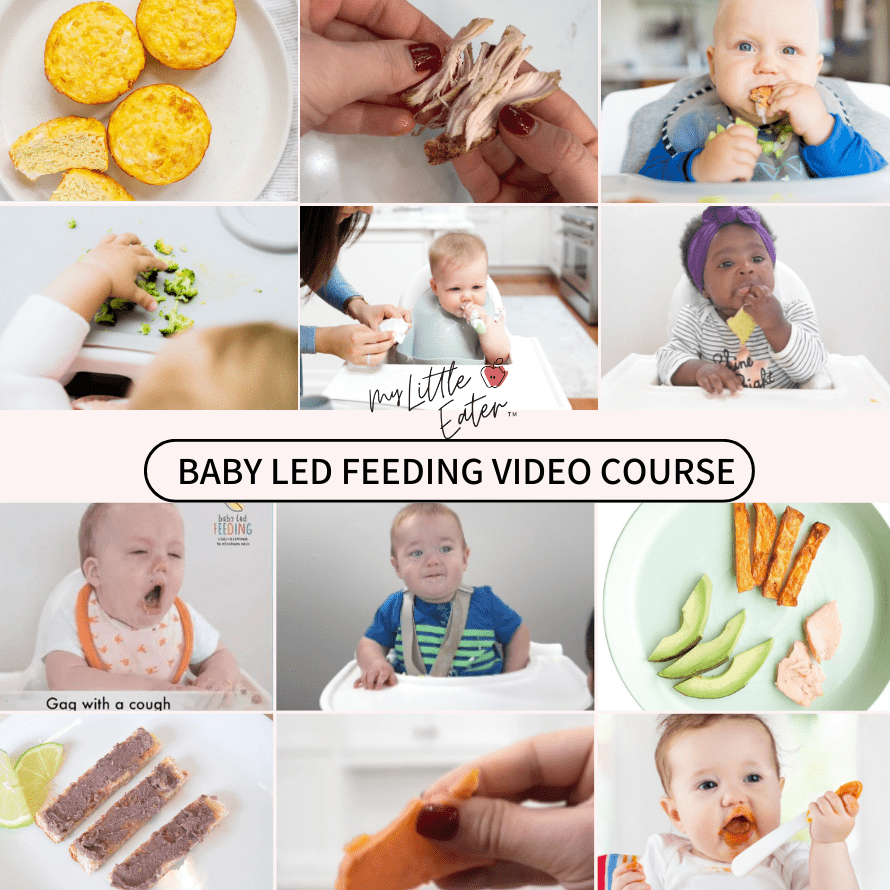
Pin it to save for later!
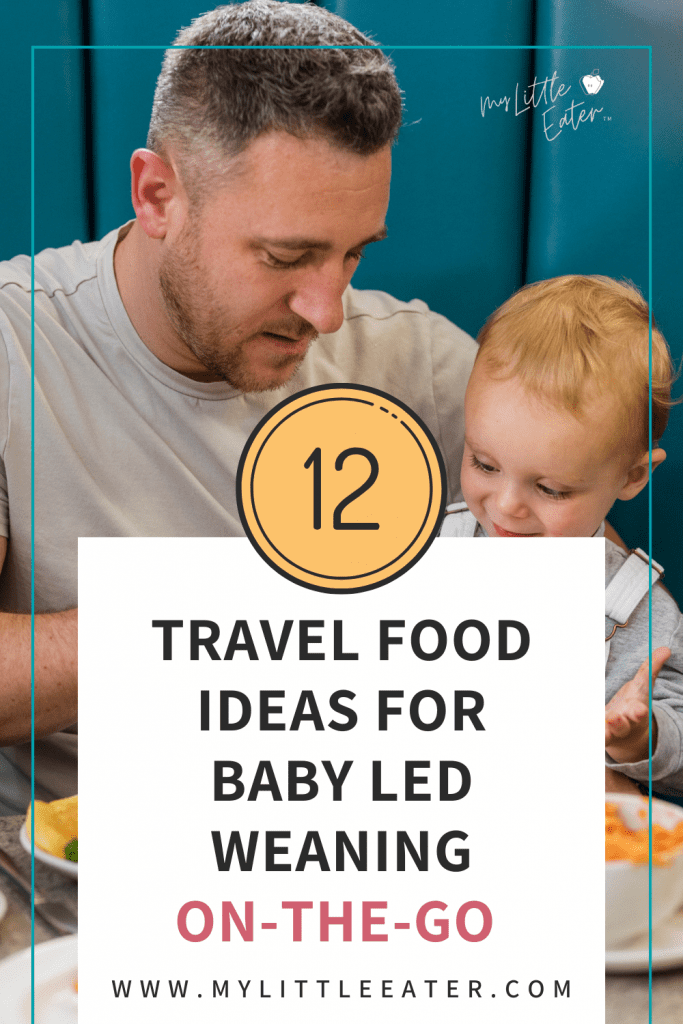
More blogs like this...
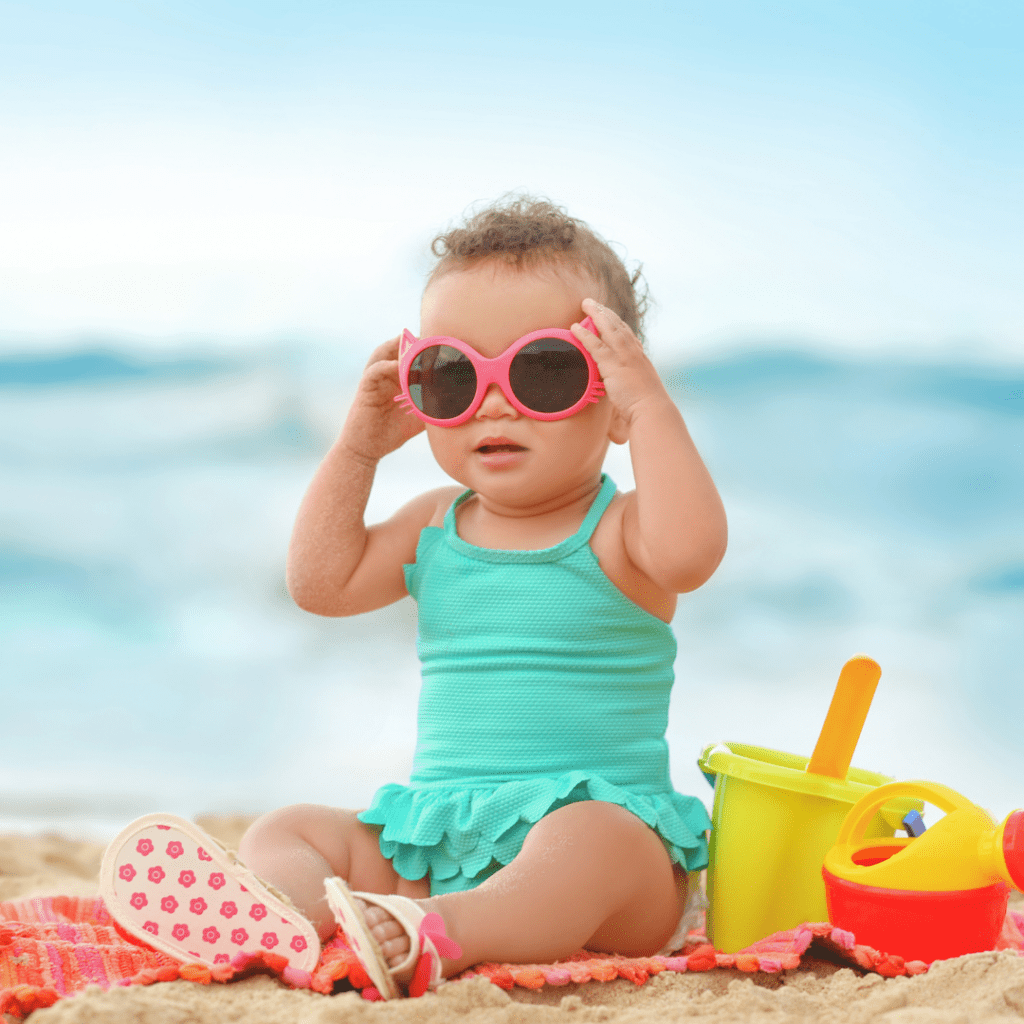
How to safely feed your baby while on holidays
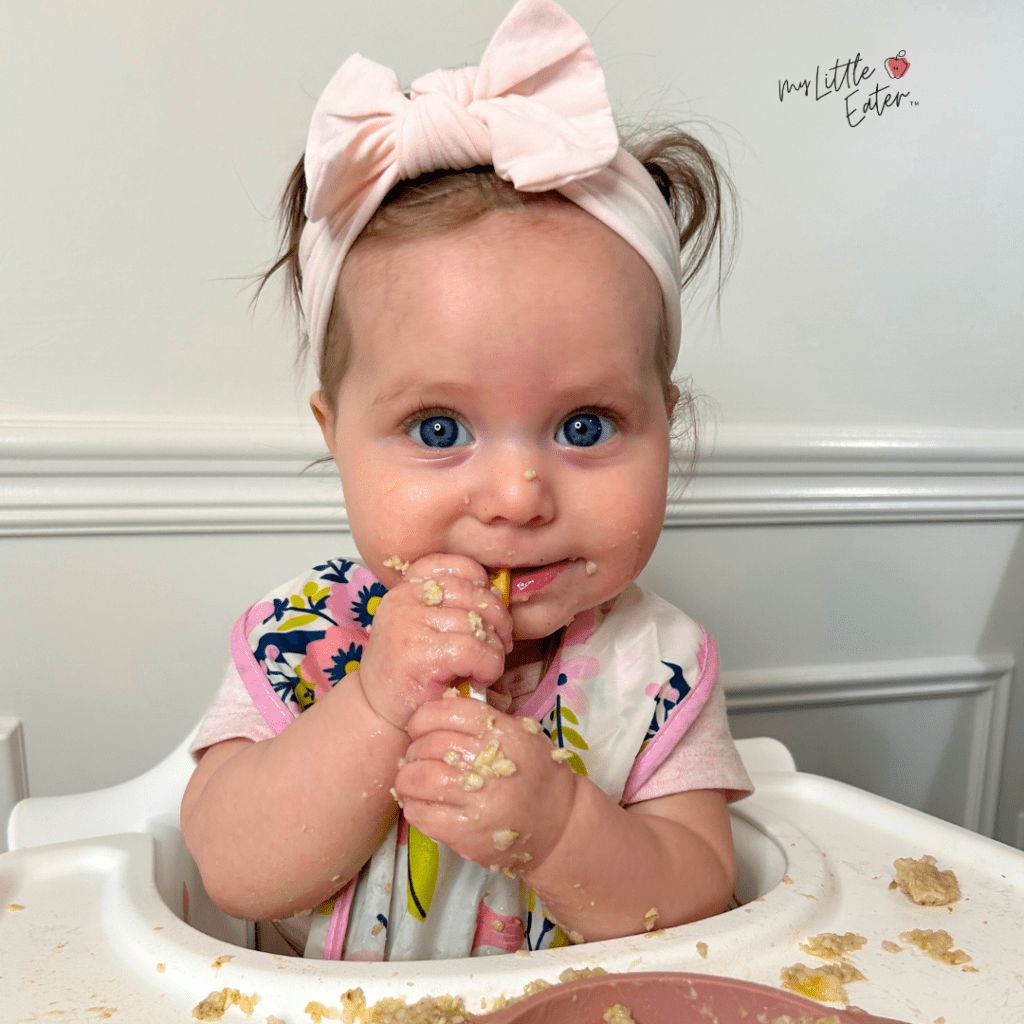
A realistic example of the first 7 days of starting solids (+ simple baby meals)
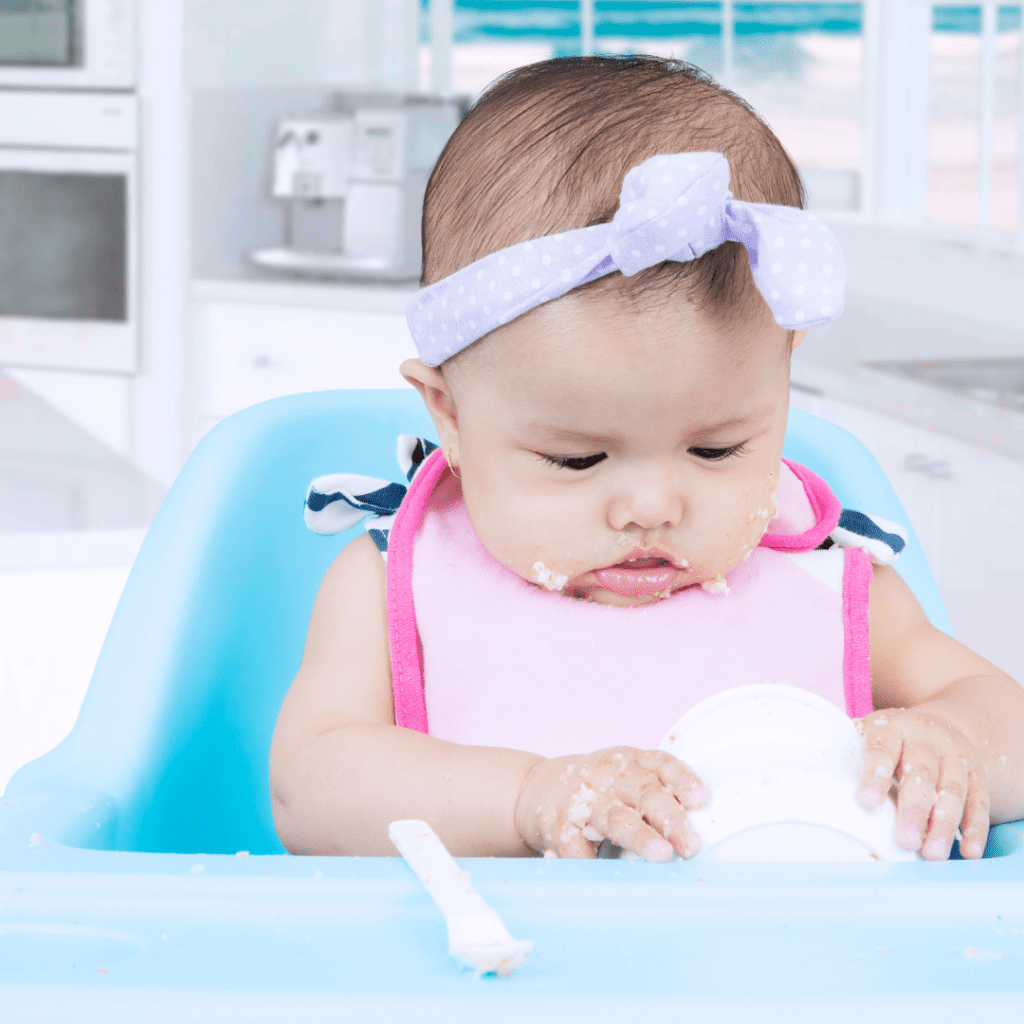
Best first foods for baby led weaning at 6 months
SHARE THIS POST

meet edwena
Registered pediatric dietitian, mom of two picky-turned-adventurous eater, and the creator of the Texture Timeline™ – an exclusive tool to help move your baby through easy to more advanced purees and finger foods to prevent picky eating.
You may also like...

Baby's 115 First Foods Checklist

60 Day Baby Led Feeding Meal Plan

My Little Eater App (for apple/android)
scared to transition to finger foods?
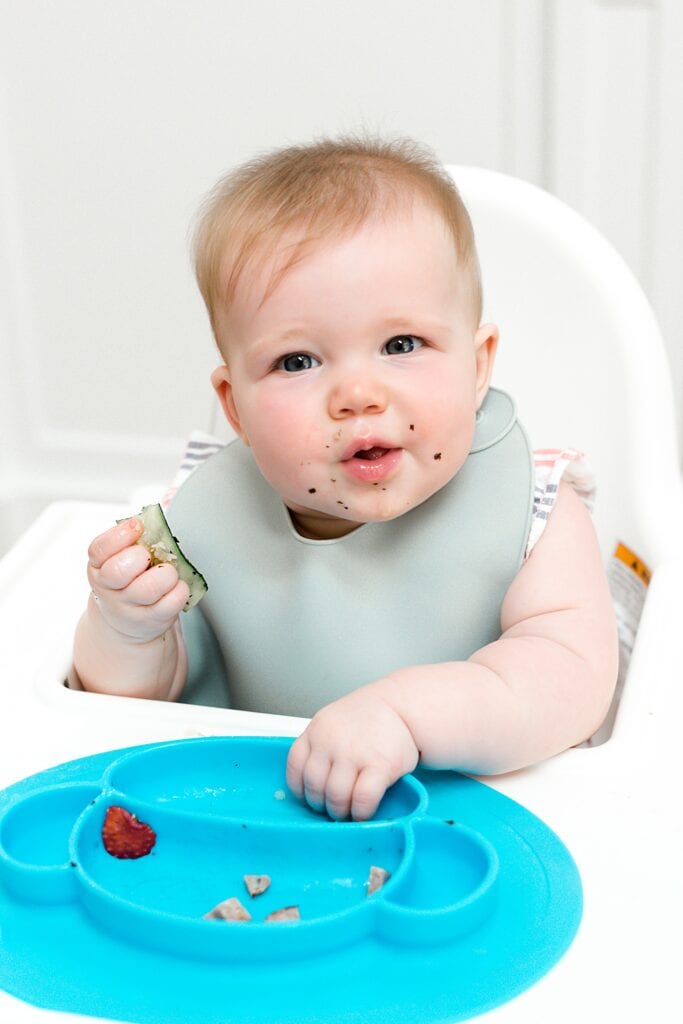
Join the FREE workshop
Baby led weaning...but make it purees!
Get our proven, step-by-step plan for transitioning your baby from Purees to Finger Foods, texture by texture, so you can ease your fears about choking and gagging, all while helping your little eater develop their eating skills and an adventurous appetite.
Plus get The Texture Timeline™ Starter Guide for free when you stay until the end of the workshop. This tool breaks down the 4 phases, what kinds of foods to safely feed your baby during each phase, and when to progress to the next phase.
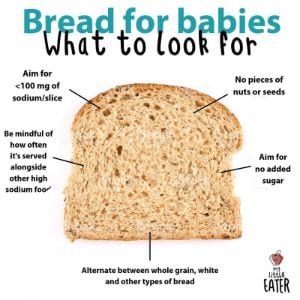
THE COURSES
Privacy Policy | Terms & Conditions | Disclaimer | Disclosure

My Little Moppet
Top Parenting blog in India
34 Easy Homemade Travel Foods For Babies and Toddlers
Published: June 8, 2015 | Last Updated on: June 6, 2023 | by Dr Hemapriya
Before we dive into the world of travel foods for babies and toddlers, let’s embrace the evolving trends of parenthood. Gone are the days when parents had to wait for their children to grow up before embarking on adventures. Nowadays, little ones join in on the exploration, their curious eyes witnessing the vast wonders of the world. While modern conveniences have made life easier for parents, one concern remains: what to feed their children while traveling.
Given the concerns surrounding packaged food and unhygienic food preparation in restaurants, many parents prefer to take matters into their own hands. This requires meticulous planning, but worry not! We are here to lend a helping hand. To ensure a seamless journey, we have curated a collection of convenient and nutritious travel foods for babies and toddlers. Let’s embark on this culinary journey together, making travel an enjoyable experience for both parents and little ones.

If you are breastfeeding your baby, there’s no need for any additional milk supplement during your journey. However, if your little one has been weaned, you can consider using substitutes for milk such as formula or commercially available milk powder. To prepare these substitutes while traveling, simply carry hot water in a thermos flask and mix it with the powder. This ensures that your baby’s milk is ready whenever needed, making it a convenient option for travel foods for babies.

Fresh fruits are one of the best travel foods for babies, being convenient and and hygienic. For toddlers, you can just cut up the fruit and feed them. For babies, you can mash and puree fruits like papaya , muskmelon , banana or chikoo . When ripe enough, they can be easily mashed with just a fork.
Instant Porridge

Here is a list of 15 instant porridge powder recipes , all of which require only hot water to be added.
No time to make these powder, no worry !! Just click, order and get home delivered here . We also have Instant food ‘trial’ packs available now, because you can never tell what the baby might like!
Main Meals – Lunch

Main meals like lunch and dinner are a little more difficult to handle while travelling as it isn’t easy to prepare a filling rice meal on the go. However, you can still work your way around this problem with a few tips:
1. If you have a rice cooker then all you need to do is plug it in to make a simple khichdi with carrots or potatoes. You can carry carrots and potatoes as they last for more than 2 to 3 days without refrigeration.
2.For a convenient rice meal while traveling, dry roast rice and dal, grind them into a powder, and carry it in an airtight container. Mix the powder with hot water from your flask to cook. You can also add grated carrot for added nutrition. Discover more travel foods for babies to make your journey enjoyable and hassle-free.
If you don’t have time to dry roast rice and dal, you can easily order homemade Instant Khichdi mixes here .
3. If you want to give lunch from a restaurant, ask for steamed hot rice with dal. Mash it with sanitized fingers or spoons and feed your baby.

When it comes to snacks, most parents reach out for packaged foods like biscuits. But you can go healthy here too, especially since toddlers snack a lot and you don’t want so much junk going into their bodies! Try these homemade snack recipes that don’t require refrigeration.
- Roasted chickpeas
- Energy bars – Groundnut Bars, Maple Oat Cluster Bars , Chocolate trail Mix
Tips for Feeding your Baby at a Restaurant

Sometimes, you find yourself with no option but to feed your baby from a restaurant. In such cases, there’s no need to panic; just keep these few tips in mind:
1.Ensure the safety of your baby while feeding from a restaurant during travel. Avoid giving raw foods like salads or chutneys. Opt for cooked and suitable meals. Prioritize the well-being of your little one by following travel foods for babies.
2. Along with raw foods, you should also avoid dishes with raw ingredients like mayonnaise, souffle, sushi etc.
3. Always try to go for steamed foods – steamed rice, steamed idlis and cooked vegetables.
4. Use your own cutlery.
5. Ensure a safe eating experience for your baby by eliminating choking hazards from their food. When preparing meals, cut or mash food into appropriate sizes and avoid giving small, hard, or round foods that may pose a risk. Prioritize your baby’s safety during travel by following guidelines for travel foods for babies.
6. Prioritize your baby’s safety while traveling by avoiding new foods that may cause allergies. Stick to familiar and trusted options to ensure a worry-free journey. Explore travel foods for babies that are suitable and known to your child.
7. Stick to boiled/bottled water and don’t give baby juices or milkshakes.
8. Stay away from anything with artificial coloring or flavoring.
Don’t let the stress of feeding your baby or toddler during travel weigh you down. With some thoughtful planning and preparation, you can ensure a worry-free journey filled with delightful moments. Bid farewell to food-related concerns and embrace the convenience of travel-friendly and nutritious options for your little one. Let us be your guide in making your travel experience smoother and more enjoyable with our helpful tips and suggestions on travel foods for babies. Bon voyage and happy travels!
If your baby has recently started on solids, you might also want to check out our detailed post – High Chair Vs Booster Seat: Your Ultimate Guide to Buying a Feeding Chair. Some of the feeding chairs recommended in this article are travel friendly too!
We have compiled a comprehensive Travel Food packing List for Babies and Toddlers

- Dr Hemapriya
- Fabida Abdullah
- Dhvani Shah
Buy Healthy Nutritious Baby, Toddler food made by our own Doctor Mom !
You may also like.
![Instant Poha Moongdal Porridge powder for babies [Easy porridge recipe for Travel] Check this out! Instant Poha Moongdal Porridge powder for babies [Easy porridge recipe for Travel], a perfect nutritious travel food for your little one!](https://i0.wp.com/www.mylittlemoppet.com/wp-content/uploads/2022/07/25182508/feature.jpg?resize=150%2C150&ssl=1)
December 28, 2021 at 12:18 pm
Dear Dr. Hema,
Could you please suggest some travel foods for 2.5year toddler. I know by this age toddlers eat most of the foods, but mine doesn’t. Hence seeking your advice. Is it safe to offer outside food to 2.5 yr kid?
January 10, 2022 at 3:00 pm
Hi Madhavi, You can try the recipes given in this article. It should be a hit 🙂 You can give outside food if it’s from a trusted source.
February 3, 2021 at 1:20 am
Plz give ideas of travel food for 8 months old baby, for one week. Any suggestions and advices are welcomed
February 4, 2021 at 8:14 pm
The blog has so many ideas. Please use it according to the age recommendation. Hope you find it helpful 🙂
November 12, 2018 at 9:39 pm
hi Dr I m going to travel in train for 25 hrs can you suggest home made food for my 11 months old baby. he has cool body so pls tell me can i give him uncooked apple?
November 13, 2018 at 5:20 pm
Hi Revathy,
Please find link below with easy travel recipes. Hope this helps you. Link – https://goo.gl/2V9Zm4
August 31, 2018 at 7:45 pm
Hiii mam….I am travelling to North…. For 15days….. My baby is 10months old…. Can pls suggest me instant receipes… (no cooking)
September 5, 2018 at 11:09 pm
Kindly check on the link below for travel food ideas dear. You can also check for instant mixes from our shop. Hope this helps. Happy and safe journey 🙂
Link – https://goo.gl/3DUmJH
April 10, 2018 at 1:26 pm
Hi Doctor, I m traveling to north india for a week with my 1 year old… i will not have access to kitchen would like to purchase a few instant packs from you. I haven’t introduced my baby to anyinstant foods. Could you please suggest me a few required ones please!
April 12, 2018 at 12:55 pm
Hi dear, Thanks for choosing to purchase our products, you can choose and order from our instant packs here: https://goo.gl/MsrRpE
January 7, 2018 at 9:22 am
Could you suggest some veg food ideas for a 24hr train travel.. It is for a 1yr old kid.
January 8, 2018 at 11:37 am
Please check some of these options dear https://www.mylittlemoppet.com/homemade-travel-food-ideas-for-babies-and-toddlers/
November 13, 2017 at 5:19 pm
Hi Hema madam, As I m traveling out of my city for 15days with my 1.5 months old son.. Plz suggest some snacks for him..
November 14, 2017 at 1:16 pm
Dear this article has most options for kids and you can also check on our site for some wonderful ways to keep kids engaged. Just type “Travel” in search box.
September 20, 2017 at 4:29 pm
Hello Hema, I will be travelling on a 10 days holiday to New Zealand with my 8 months son in November. Please suggest me instant food I can give him thrice a day. I am very much tensed about his health during our stay at that time.
Thanks in advance
September 20, 2017 at 5:47 pm
Dear, while on travel the best bet is to feed, fruits, boiled potatoes, eggs, dry snacks (like biscuits which can be made and carried along). If you must feed outside you can take boiled rice and give along with curd, or some mashed fruit based on your kids preference. Also in most places now you get indian foods so that is another option you can pick while on travel. Don’t worry much, kids too adapt to changed food.
September 1, 2017 at 10:53 pm
Hi Mam..We r traveling for 4 to 5 days confused about water how will boil water or can v give bisleri to 10 months baby..? As flask will serve purpose only for 1-2 days..plz help with other options?..
September 21, 2017 at 10:32 pm
You can always request at some places restaurants etc. to help you with boiled water.
March 31, 2017 at 11:54 am
I was wondering if bottled mineral water should be boiled before being given to a 1 year old
May 7, 2017 at 6:20 pm
You can give it like that also, as eventually we have to give them such water.
October 4, 2016 at 3:56 am
Thanks alot for this information…..
October 19, 2015 at 5:22 am
Quick qs !! For the porridge do we need to soak dal and rice then dry to make a powder ? Or we can directly powder it.
Thanks, Akshita
February 29, 2016 at 4:55 pm
Dear Akshita,
You can check the recipe here
October 16, 2015 at 1:25 pm
These recipes were really helpful. Also please tell me how can we add sweetness to it. I have been using jaggery for my lil one. Now for these instant porridges, other than fruits what can be added for sweetness. Please help. Thank you
February 29, 2016 at 5:07 pm
Yes fruit purees can be added for sweetness
June 9, 2015 at 12:14 pm
Hi.. This post is very timely, we are travelling to Europe with my 15month old in July. I am quiet confused about what food to give him and also Milk. The instant porridge recipe needs no cooking? just hot water will be enough? Pls share any other tips you have.
June 9, 2015 at 5:13 pm
Hi apeksha,
Yes the instant porridges do not require cooking. Just add hot water and it is done,
September 9, 2015 at 5:35 pm
hello ma’am!! is warm water ok? for making instant porridges?
October 26, 2015 at 1:08 pm
The water has to be hot for cooking porridges or else the powder will not get cooked .
Hope this helps
Leave a Reply Cancel reply
Your email address will not be published. Required fields are marked *
Save my name, email, and website in this browser for the next time I comment.
Browse & Buy Our Products Online
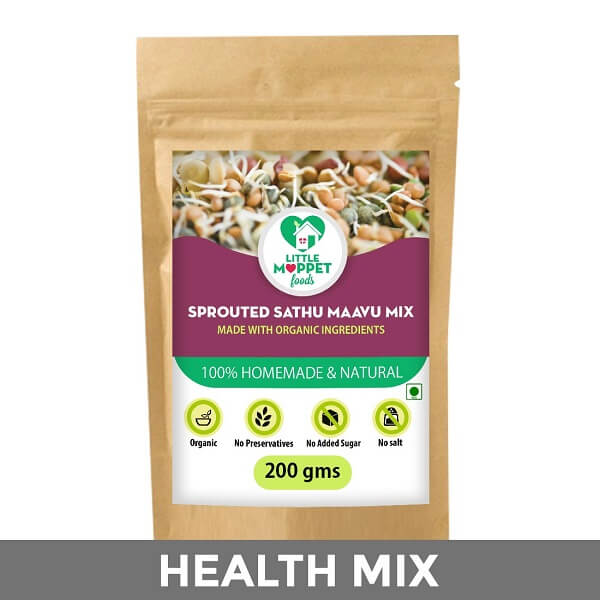
Useful Links
Our facebook page.

75 Tips for Traveling With a Baby (Free Packing Checklist)

When traveling with a baby, there are so many little things to remember (and forget!). Taking a family vacation with an infant, baby or toddler doesn’t have to be a challenge when you know what to bring. This guide to packing a diaper bag and must-have baby travel essentials for little ones will help!

Mom Rewritten uses affiliate links which means I may earn a small commission if you purchase through the links in these posts. As an Amazon Associate I earn from qualifying purchases. For more information, see the Privacy Policy and Disclosures tab.
This shop has been compensated by Collective Bias, Inc. and its advertiser. All opinions are mine alone. This article originally published September 5th, 2016 and has been updated and republished with a new date.
Best Tips for Traveling With a Baby
I remember the first time I took my baby on her first extended vacation. There was so much to remember when I packed! Not only was I figuring out my own suitcase there was also my baby’s supplies to tote.
Are you overpacking for your baby? Or not packing enough? It’s a careful balance to be sure. You don’t want to be that traveler jamming the car full of unnecessary items because you think the baby needs it all . This article will help you pare down to the basics that will still allow you to travel with ease.

How to Pack for a Trip With a Baby
Whether headed to the beach, camping, city or theme park, when traveling with a baby in diapers you’ll need the same important essentials.
Keep reading for the helpful vacation guide with tips on taking the baby on a trip. There’s also a free baby packing list you’ll want to print and use when filling the luggage.
I’m sharing suggestions for toys, swim and bath products and road trip requirements. And of course figuring out that all important number of how many diapers to pack for your travels!

Baby Travel Essentials – Can You Buy It When You Get There?
Depending upon where you’re going, you might need to pack everything you’ll need upfront. This could be because the location in which you’re headed might not have the supplies you need. You may not want to replenish or purchase when you get there because of higher cost concerns.
If possible, consider these options which include shipping the items or buying there. If you know the products you need are readily available in stores, wait and buy it when you get there. That’s a decent idea if you don’t want to have to pack and tote bulk consumable items like baby formula and diapers.
Another option is to have the items shipped to your destination. If you’re staying with family, that’s an easy choice. Purchase items online and have them sent ahead of your trip so the packages are there before you arrive.
Call hotel locations ahead of time to verify what their policies are for accepting deliveries. Some hotels will have requirements for the shipping label, timelines for holding packages or may charge a fee.

Diapers and Wipes are Top of the Baby Packing List
When it comes to traveling with a baby, it’s easy to over pack. But when diapers are concerned, you never want to be stuck without! This is how to figure out how many diapers to bring with you on the trip.
How Many Diapers to Bring on a Trip?
So, how can you figure out how many diapers to bring with you on a trip? In the week leading up to your vacation, take note of how many diapers you go through each day with your baby.
I kept a notepad and a pencil on the shelf above my baby’s changing table to make a tally. Average the number of diapers you’ve used over the week to figure out a daily amount and then multiply that by the number of days you’ll be away from home.
Just to be on the safe side, put in about two extra diapers per day of your trip…just in case!
Do the same for the baby wipes but definitely bring additional extras of these. WaterWipes baby wipes are convenient for cleaning messy fingers and faces as well as bottoms!

Best Travel Clothes for Babies and Toddlers
When traveling with your baby in diapers, consider these logistics for choosing the best vacation outfits. Pick breathable fabrics that will be comfortable during long drives in their car seat.
Only choose separates that make diaper changes easy. Avoid outfits with buttons or snaps on the back of the clothing. These can be uncomfortable for babies to lay on for long periods of time.
Zip Footie Pajamas – For infants, skip those fancy outfits and go straight for the pajamas all day. Avoid multi-piece outfits that will bunch up and cause discomfort for a baby. Grab this organic cotton zip-up footie from Primary in all the colors!
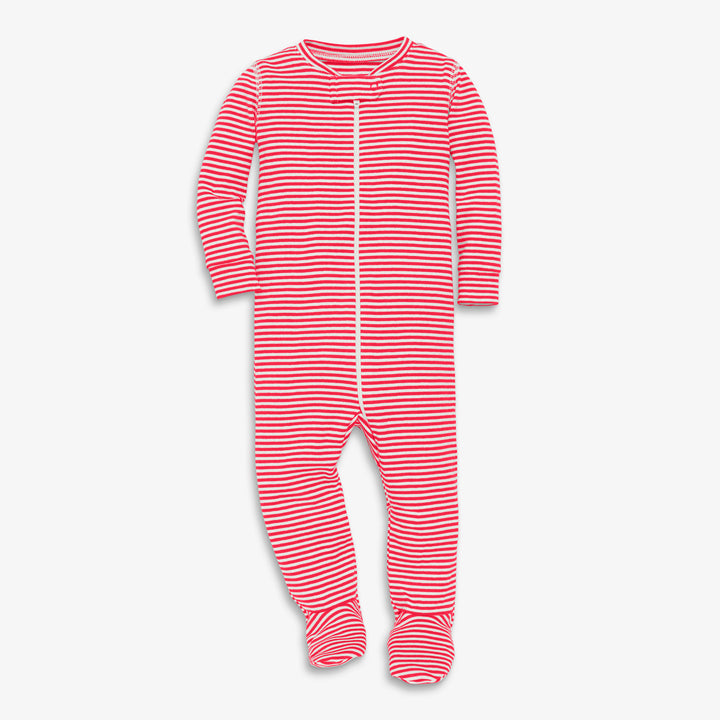
One-Piece Rompers – When traveling with a baby in diapers, snap-crotch bubble onesies are probably the most ideal when the weather is warm. Look for long sleeved one-piece jumpers with a snap crotch when it’s chilly. Toddlers will appreciate the comfort factor. You’ll appreciate the quick diaper changes with clothing that’s simple in design!
My go-to for the best children’s clothing is Primary . They offer gender-neutral mix and match pieces in every color of the rainbow. Lots of coordinating outfits to match older siblings too! Use code AFT20PCT to save 20% and receive free shipping on your first order.

Sun Hat – If you’re planning to be outdoors, a baby sun hat is required. Opt for a stylish version like this with a wide brim, breathable materials and a chin strap to keep it secure.

Must-Have Baby Travel Toys
Older kids can leave their toys behind when they go on vacation. But it’s important to pack a few toys for the baby whenever you leave home. Toys can help with boredom, especially if the baby is kept in their car seat or stroller for longer than usual periods of time.

If your baby has a few favorite items, be sure to bring those on the trip. In addition purchase a few new baby travel toys for variety while traveling. When your child gets fussy, surprise them with one of the new items!
Travel Teething Toy – If you have a teething baby you know that gnawing is a big deal! This teething mitten offers up safe-to-chew bumpy grooves and ridges. The adjustable Velcro strap secures the glove to baby’s hand so the toy is less likely to fall on the floor or get lost.

Car Seat Toys – This soft cotton hanging toy mobile spiral-wraps around the handle of the car seat with dangling toys for baby to play with.

Electronic Baby Toy – Babies love the stimulation of lights, sounds and music! VTech rules when it comes to educational electronic baby toys. This small-sized Happy Lights Bear serves up songs, phrases and flashing lights. The cuddly bear Velcros to the stroller or car seat.

If you’re traveling on public transportation or on a plane, avoid anything with annoying or loud sounds so as not to disturb other travelers! Relegate noisy electronic items to the rental car only.
I have an extra tip to minimize the noise of electronic toys. Place a piece of electrical tape over the speaker to quiet the sound when there’s no volume control.
Baby Toy Straps – Keep toys from dropping on the ground with silicone baby toy straps . Secure rattles, chew toys and sipper cups to the car seat, high chair or stroller to prevent them from getting lost or dirty.

Baby Travel Essentials for the Hotel
One of the most challenging things about traveling with a baby is sharing a hotel room. When baby goes to sleep, generally everyone else has to turn off the lights and be quiet too! Consider booking a suite with a separate bedroom door. This way if you have older children, they don’t have to go to sleep when baby does.

Inflatable Bath Tub – If baby is too small to sit up or too big to fit in the bathroom sink for a wash, consider packing this. The inexpensive Inflatable Duck Tub will make bath time easier and it won’t take up any extra space in your luggage.

Touch-Control Night Light – Moving around blindly in a dark hotel room when baby wakes at night is recipe for disaster. You don’t want to turn on a light and risk waking everyone else up either.
Away From Home Sleep Needs for Little Kids
Whether driving or in a crib, nap and sleep routines are important to maintain when traveling with babies. A disrupted sleep pattern can cause havoc, resulting in overly grouchy behavior. Aim to travel during regular nap times in the hopes that baby will sleep while driving or flying.
These baby travel essentials can help regulate naps and nighttime sleep for your child:

Car Seat Head Support – If you’ve ever rigged up your own head support for the toddler sleeping in a car seat, this is the road trip product for you! This simple to install Car Seat Child Head Support keeps toddlers heads from slumping when their napping.

Sun Shade – Nobody likes the sun in their eyes, especially young kids who are trying to rest. Block out the rays and heat during long car trips with a simple window sun shade . This one stretches to fit and has suction cups to secure on the glass.

Sleep Sack – Skip the blankets in the crib and use a muslin sleep sack for bedtime. The fabric is soft, breathable, and lightweight but will keep baby warm enough if the hotel air conditioning is running.
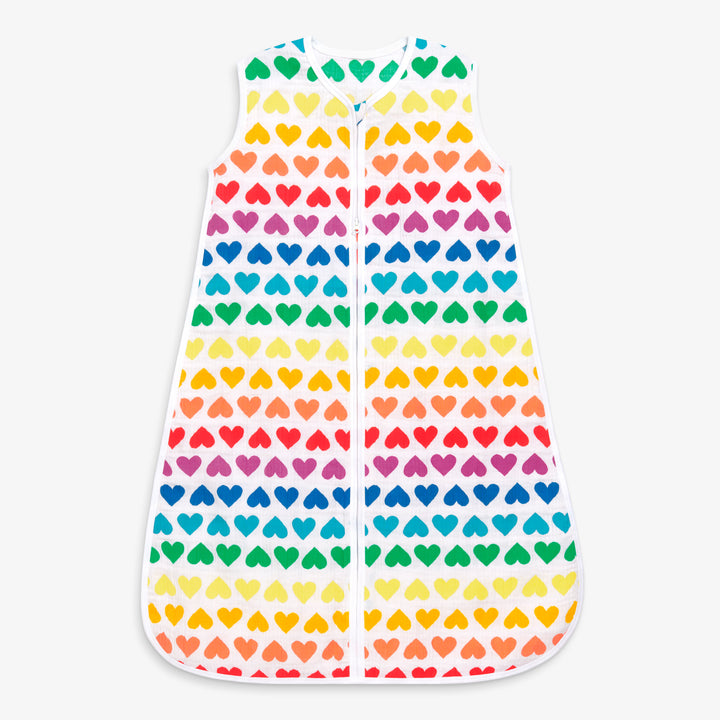
For colder nights or in outdoor locations like on a camping trip bundle toddlers in a warmer sleeper sack . This version has foot openings for walking babies. There’s diaper access via a reverse zipper.

White Noise Machine – If the strange noises at a hotel are interrupting your baby’s usual sleep patterns, this VTech White Noise Sound Machine is perfect. Petite-sized for travel with a rechargeable battery, it features both gentle lullabies and ambient sounds.

Baby Travel Essentials for Flying
Sucking can help relieve ear pain with babies during elevation and descent on an airplane. Chewing gum can help older kids and adults. For babies try using a bottle, pacifier or breastfeeding. My friend Leslie at Trips With Tykes has tons of helpful tips for flying with a lap child .

Pacifier – Each baby seems to have their own preference of pacifiers. And some babies (like my daughter) refused to use one. Have a few on hand just in case.
If traveling with a pacifier is essential, make sure the Nuk doesn’t get lost on your travels! Secure pacifiers to baby’s clothing with one of these convenient pacifier clips .

Keeping a Toddler Happy While Traveling
Whether you’re flying or hitting the open road, keeping toddlers happy while traveling can be tough! I recommend scheduling your travel times during their regular nap schedule. If you can ensure that your younger child takes a nap this can make everyone’s trip go a little smoother!

Car Seat – If you’re flying somewhere and will need a car seat when you get there, bring the seat onto the plane. Your toddler will have a comfortable and safe place sit in the airplane. And bonus, they’re more likely to nap if they’re latched into their car seat!
My favorite car seat to travel with is the inexpensive Cosco MightyFit 65 Convertible Car Seat . Rear-facing for babies from 5-40 pounds or forward-facing for children 22-65 pounds. It’s also reasonably lightweight and easy to install into a rental car.

WikkiStix – The perfect travel craft, WikkiStix are mess-free and easy for little ones to use. These soft and pliable bendy sticks adhere to each other or to a smooth surface for ideal quiet time entertainment.

Reading Material – Pack a few baby books but make them lightweight and able to hold up to wear and tear. The Indestructibles Baby Book series are great to entertain toddlers with a story on the road. Or baby can just chew on the pages, whatever!

Swimming and Sun Tips When Traveling with a Baby
If you’re planning a full day in the sun, make sure that your baby is well protected from sunrays and heat. This means extra hydration, just like you should be getting.
Babies should be nursing or bottle feeding more often. Older babies and toddlers should drink water or Pedialyte to keep them from getting dehydrated. These are the baby travel essentials when you’re outdoors or traveling during the hot summer season:

Swim Diapers – A necessary packing item if you plan to let baby swim. Whether in the hotel pool or at the beach swim diapers are a must.
If you prefer an eco-friendly option, choose a reusable swim diaper like this version with side snaps. This preference works best if you have access to a bathroom toilet and washing machine while traveling.

Pop Up Beach Tent – An open sided Beach Shelter offers an escape from the direct sun, essential for babies and young children. This version has a flat bottom to keep sand away, windows for ventilation and a hanging hook for a battery operated fan. It folds down like a car sun shield into a tiny carrying bag so it’s excellent for travel to any beach locale.

One-Piece Rash Guard – Choose a swimsuit with built-in UPF 50+ sun protection. This Primary long sleeved rash guard is all one piece but still has a snap gusset for fast diaper access.
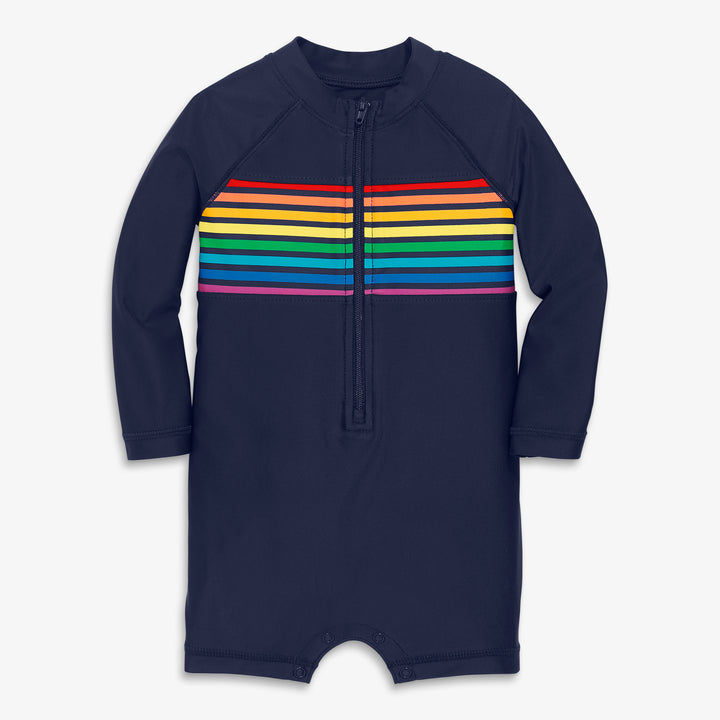
Pool and Beach Baby Travel Essentials
Depending upon the age of your child, one of the following versions of pool floaties might work for your needs. Naturally, these floaties aren’t a replacement for supervision. Parents should remain within arms reach of their baby around water.

Baby Spring Float – This SwimWays Baby Spring Float offers younger babies a gentle way to float on the water while keeping their face dry and out of the sun. The product is also easy to close and carry so it’s ideal for taking on a trip.

Kid’s Life Jacket – This SwimWays Sea Squirts Learn-to-Swim Life Jacket is not inflatable and therefore will take up more space in your suitcase. But if you’re planning to be in the water a lot, the safety factor of this Coast Guard approved product might outweigh. Be sure to read the description on weight and size to ensure this will properly fit your child.

Suncreen – A travel essential for everyone, whether the sun is shining or behind clouds. Look for varieties like Babyganics Mineral Sunscreen . Ask your pediatrician to know their recommendations for application of sun protection lotion onto newborn skin. Reapply often, especially after water exposure.

Sunglasses – Headed to the beach or some place where the sun is particularly bright? A pair of baby sunglasses can help keep crankiness down when the sun is out of their eyes.

Baby Travel Essentials for Feeding Away From Home
Whether you’re feeding from the bottle or the breast, eating in a restaurant or on the road, these are some of the must-have items when traveling with a baby.

As a nursing parent, you can breastfeed your baby any where you wish. Some babies are challenged with nursing in public because they are distracted by activity around them. A nursing cover up can come in handy if you prefer privacy when breastfeeding or if your baby needs less distraction.
Nursing Cover – Choose a nursing cover up that’s lightweight to prevent overheating. The Milk Snob Nursing Cover doubles as a cocoon for infant car seats.

Snack Cups – These spill-proof Snack Keeper cups hold food with soft flaps on top for access. Fill them up with Goldfish crackers or animal crackers for the perfect to-go toddler snack.

READ MORE: How to Choose Healthy Road Trip Snacks at the Convenience Store
Sipper Cups – We all try our best to keep track of everything when traveling. Inevitably something ends up missing. It’s usually the sippy cup that rolls under the car, falls out of the stroller or gets left at a restaurant.

Skip the pricey sippers and buy a set of these Take & Toss Spill-Proof Sippy Cups . If one gets lost, you’ll have a few to spare.

Bibs – If you have access to laundry, these machine washable bibs are superb for feeding time. In a pinch use a baby wipe to clean off small messes.

No washing machine, no problem. Disposable bibs offer protection to clothing from food spills and can be tossed in the trash after each use.
An excellent reusable choice is the Bib Clip . Especially convenient for frequent restaurant dining, simply snap in a cloth or paper napkin to protect toddler’s clothing.

Disposable Placemats – If your toddler is self-feeding, these disposable placemats are awesome. We all know that kids don’t keep their food on the plate! To keep mealtime a little neater and more sanitary these peel-and-stick plastic mats are a must.

Comfortable Shoes for Babies
If your baby has only crawled around the carpeted floors at home you might not have even purchased them a first pair of shoes. Generally a pair of socks will keep baby toes warm and dry.

However when away from home consider covering baby’s feet to protect them when traveling in public locations. Choose flexible soles that don’t require a “breaking-in” period.
My children have been wearing pediped brand shoes since before they could walk. The pediped Originals are perfect crib shoes that can transition into walking shoes for a toddler.

Aqua Socks – If your child will be walking on hot sand or on the concrete around a pool, consider slip-resistant water shoes . They are a safe way to protect toddlers from stubbing their toes or burning their feet.

Walking Outside with a Baby
If your travel destination includes a lot of walking you’ll need to be prepared for taking baby along for the ride. Follow these additional tips for walking outside with a baby .

Stroller – The Baby Jogger City Mini has been my favorite for traveling with a baby. It’s all-terrain for both sidewalk or trail walking and offers excellent recline for naps. Best part is that it closes up compactly with one hand, ideal for boarding public transportation or getting into the vehicle trunk.
If you’d prefer not to take your own stroller consider renting one at your destination. Companies like Kingdom Strollers that rent equipment at Walt Disney World are one of the top places to get a stroller while traveling.

READ MORE : Guide to taking toddlers to Walt Disney World Magic Kingdom .
Stroller Fan – When the weather’s hot, keep baby cool using a flexible Travel Fan . Wrap the arms around a stroller, car seat or hold it in your hand to create a breeze wherever you need one.

Muslin Blanket – This lightweight muslin blanket in a variety of colors is multi-versatile. Use it as a blanket, burp cloth, swaddling cloth, nursing coverup or to cover the stroller when the sun is out.

Front Carrier – Best for going where strollers can’t go, the baby front carrier is invaluable. It’s also convenient to use when babies are sleeping and you don’t want to wait until nap time is over. Put the baby in a front carrier and go about with your exploring!

A Front Carrier is also highly convenient in places where you need to be hands-free. Airplane travel and amusement park queues are perfect locations to use a carrier. Plus nursing parents can discretely feed their baby inside of a front carrier!
I also used a front carrier to help soothe my fussy toddler to sleep at hotels. I’d pop her in the carrier then tidy up the room and get things ready for the following day until she was asleep.

Toddler Backpack with Harness – Ideal for the toddler who is always trying to run away! This Skip Hop Toddler Backpack has a leash that can be detached. My daughter enjoyed carrying her sippy cup, plush toy and a snack in her bag. The removable leash allows toddlers to walk independently but not get too far away.

Choosing the Best Diaper Bag for Travel
Before you start packing, make sure that your everyday diaper bag will work for your travel needs. You might want to purchase a day bag that’s better suited for vacationing with a baby.
Figure out first which baby travel essentials you’ll be bringing on your excursions each day. From there you’ll have a better idea which type of diaper bag is best suited to your family’s needs.

Where will you put the bag when you’re not carrying it? If you want to store it under the stroller or in a locker, make sure to measure so it’s not oversized. For airplane travel, ensure that the diaper bag will fit nicely under the seat.
Diaper Bag Tote – For longer days away or lengthy plane trips, this diaper bag tote opens wide into one main compartment. An included shoulder strap is versatile and convenient.

Diaper Backpack – A stylish alternative to the usual diaper bag that either mom or dad would be pleased to carry! This spacious diaper bag backpack houses plenty of storage pockets and space for everything you’ll need on the go.

Stroller Diaper Bag – Ultra convenient stroller caddy diaper bag hangs from the stroller handle for quick access of wipes, diapers and other essentials. A compact style that’s ideal for short trips.

Packing a Travel Diaper Bag
Bottles, baby food, diaper cream and drool bibs! Each evening when you return from outings, empty and refill the diaper bag. Reload the bag with wipes and diapers, clothing changes and baby food. Taking time to restock at night will allow for less stress in the mornings.
Besides what you usually bring for baby in the diaper bag, there are a few other baby travel essentials to consider:
Wet Bag – In the unfortunate event of a diaper blow out or spit up incident you’ll need a place to keep clothing until they can be washed. A reusable wet bag stores messy or damp clothing until you can get to the laundry.

Diaper Changing Pad – Many of the newer diaper bags already have coordinated changing pads included. For getaways where there might be diaper changing tables, purchase disposable diaper changing pads for sanitary purposes.
Stain Stick – When you’re away from the washing machine, use an on-the-go Stain Stick for laundry. Simply rub on spots to prevent stains from happening until you can wash.

Requirements for Safe Travels with Babies
If you have an active toddler there’s sure to be a few bumps and bruises along the way. It’s always better to be safe than sorry when it comes to taking care of small injuries or treating pain.

My daughter fell and scraped her elbow at Disney World. With the wet and humid Florida weather the bandages from first aid just wouldn’t stick to her skin. Now I know to pack waterproof band aids in the first aid travel kit!
First Aid Kit – A well stocked first aid kit is essential when traveling with a baby. Include cleansing wipes, antibiotic ointment and plenty of kid-friendly bandages.

Baby Medications – Kids can get sick, even on vacation. Fevers can spike quickly in the middle of the night. Better to have what you need for emergency than rely on the local convenience store or hotel gift shop. Basics like a baby thermometer and Infants’ Tylenol are a must pack.
Safety Kit – Whether you’re staying overnight at a hotel, Airbnb or at grandma’s house, you’ll want to baby-proof the accommodations. This includes protecting exposed electrical outlets, covering sharp corners, securing loose cables and locking up cabinets.

READ MORE: Complete Guide to Keeping Kids Safe on Vacation
What Else to Pack for Baby?
It can be tempting to want to pack ALL the things when traveling with a baby. Some of what you use at home on a daily basis may not be a baby travel essential. Before you overload the car’s trunk space or suitcase with oversized items, here are some tips.
Find out what’s there already before you pack your own. Check with hotels and Airbnb to find out what baby equipment is available. Verify that the products aren’t recalled.

Check with rental companies at your destination. Places like Cloud of Goods can offer up the rental of items like cribs, booster seats, pack ‘n play, stroller wagons, and high chairs.
In the case of high demand items like your baby’s bouncer seat , you might want to consider bringing it on the road. If the bouncer is the only place your baby will calm, best not to disrupt their pattern any more than usual when traveling.

How often will you use it? If you regularly use a high chair cover at home, consider if it’s worth lugging on your travels. I personally brought a high chair cover with me to Walt Disney World for my baby and used it one time. It wasn’t worth losing the space in my suitcase. But if you think that large item is essential, by all means pack it!
Baby Travel Essentials Packing Checklist
Now that you know what you need to bring when traveling with a baby in diapers, click the link below to print the free baby travel packing checklist!
Traveling with Baby – Free Printable Packing List

Subscribe to Mom Rewritten Newsletter
This site uses Akismet to reduce spam. Learn how your comment data is processed .
- Help centre
Flying with children

Travelling with young children can be a daunting task. But rest assured, we’re on hand to help your trip fly by as smoothly as possible with a few handy tips.
From what to pack onboard, to inflight family entertainment, we’re known for our family ethos for a reason. Let’s get your trip off to a flying start.
On this page

What are the different child ticket options?
Firstly, what type of ticket do you need that best suits your needs?
Check out the basics before we delve into the good stuff.
Babies up to the age of two are classed as infants. They'll usually fly in the comfort of your lap, so we only charge 10% of the adult fare (plus any taxes, fees or charges).
If you do require a seat for your infant, you’ll need to book that with us directly. Please Contact us .
While you are there you can also request a bassinet or cot , subject to availability.
You must be 12 or over to look after a lap infant onboard, and it's only one baby per lap please, or things get a bit too wriggly.
Child fares apply for children aged between two and eleven years old at time of travelling.
After you've booked your child seat, you can pre-select a kid's meal created especially for ages 2 to 12. Find out more here .
Young Adult
Young person fares apply for children aged between 14 and 16 years old at time of travelling.
Please refer to our page on Young Persons Travelling Alone for more information about our policies on young people travelling without a parent or guardian.
What you need to know before boarding your flight
- Seating options
- Checked baggage
- Hand luggage allowance
- Liquid allowance
Seating options for babies
All cots/bassinets should be requested in advance. If you already have a booking, please log in to My Booking where you can speak to an advisor via web messaging to request a cot/bassinet.
If you've not yet made your booking and wish to check the cot/bassinet availability before you book, please Contact us and let the advisor know you would like to request a cot/bassinet.
Available bassinets will be allocated in the order we receive the requests for each flight. Your seat number will be allocated ahead of Online Check In opening.
.png)
Children's baggage allowance
For children and infants who have their own seat, the same baggage allowances as adults will apply. Click here for details.
For infants on a lap (without their own seat) they’ll get one checked bag, except in Economy Light where no baggage is included.
If you're flying Economy Light, you may purchase one bag per infant at 50 GBP / 75 USD if you booked on or after 28th July 2021 or 45 GBP / 60 USD if you booked before 28th July 2021.
You can also bring a collapsible pushchair and car seat in addition to their free bag allowance. We will take this from you at the gate and pop in the hold.
At London Heathrow, all pushchairs (with the exception of Special Assistance pushchairs) are collected from the baggage reclaim.
Children's hand baggage
Babies and toddlers aged 0-23 months are entitled to one bag each weighing up to 6kg (or 13lb). Any children aged 2+ years are entitled to the same amount of hand baggage as an adult.
When travelling with infants or children you can bring a fully collapsible pushchair (which we can take from you at the gate and pop in the hold) and car seat, in addition to the free check in allowance. If you are travelling to London Heathrow, please be advised that pushchairs (with the exception of special assistance pushchairs) won’t be delivered to the aircraft door when you arrive and will be available to collect from baggage reclaim.
Alternatively, pushchairs that are a maximum of 23 x 36 x 56cm (that’s around 9 x 14 x 22 inches) when folded are permitted in the cabin with you as your hand baggage.
Please note pushchairs carried onboard are part of your hand baggage allowance, not an additional item. If your buggy does not fit in the baggage sizer at check in or at the boarding gate, the pushchair will be tagged by ground staff and checked in either at check in or the boarding gate. You must be able to place your foldable pushchair in the overhead bins unaided.
Liquid exceptions for infants and children
Including food and medication.
The following liquids are allowed in amounts greater than 100ml. Please bear in mind that you still shouldn’t bring excessive amounts:
- Baby food and formula milk, when the infant for whom the food or milk is intended for is present.
- Liquid expressed breast milk can be carried even when the infant is not present, provided that the milk is in containers not exceeding 2000ml (2 litres). The milk must not be frozen, and there is no limit on the amount of containers that can be carried. When the infant is not present, gel/ice packs can also be carried in order to keep the milk cool.
- Prescription and over-the-counter medications, whether in liquid, gel or aerosol form, including eye drops and saline solution for medical purposes. Read more about travelling with prescription medications on our Special Assistance page .
- Liquids or gels for passengers with disabilities, diabetes, or an appropriate medical condition
- Items used to augment the body for medical or cosmetic reasons, such as prosthetic breasts and bras containing gels.
Onboard your flight
Kids entertainment.
Vera is the name of our inflight entertainment system onboard your flight. Here you'll find a designated Kids section to keep your kids entertained with movies, TV, audio and games suitable for small eyes and ears.
If there is content isn't suitable for your little travellers, we've included a parental block as part of our inflight entertainment system. For help with setting this up, just speak to a member of the cabin crew on board.

- Feeding babies
Kids meal options
If you'd like to order any children's meals you need to do so separately which can be done easily online in My Booking . You can do this any time from booking up to 24 hours before your flight.
.png)
We’ve created our kids’ menu with the fussiest child in mind, so it includes a variety of familiar dishes that are sure to tickle their tastebuds. It's designed for children who are aged from 2 to 12 years old and have their own seat.
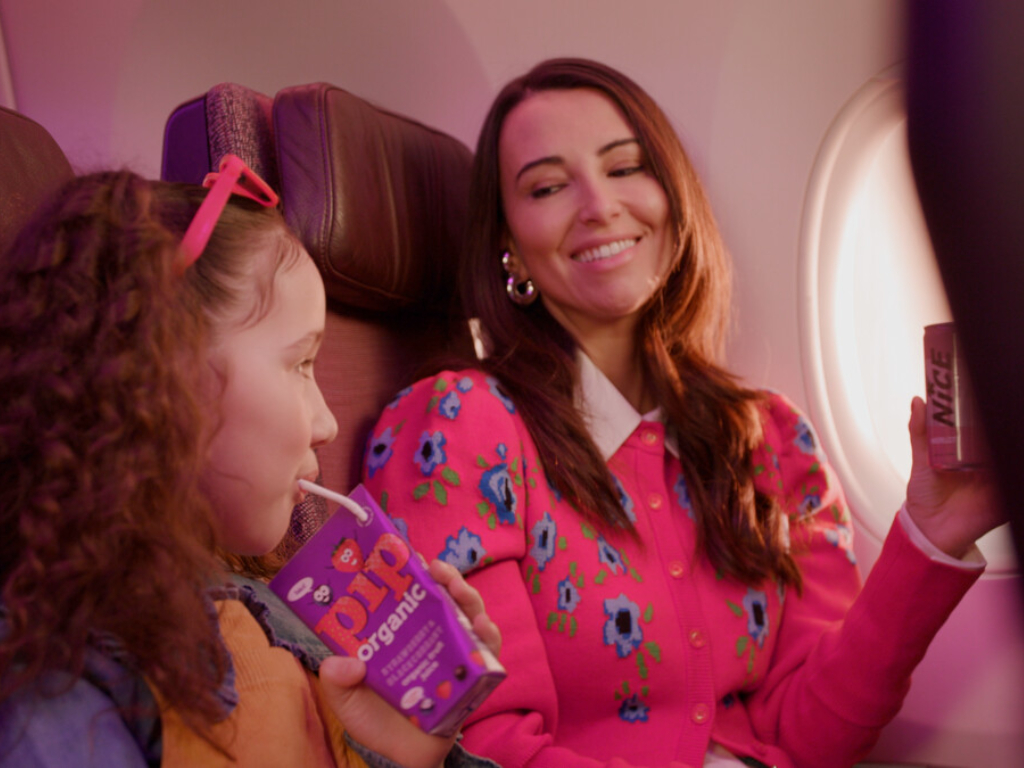
Kids meals aren't always vegetarian, so if they're veggie they should go for the adult vegetarian option rather than a kids meal.
If you don't order one before you fly it's ok, they'll be able to choose from the delicious options available onboard.
Our nut allergen policy
We adhere to allergen guidance under European and UK food legislation, which may be different in other jurisdictions. The allergens declared refer to the ingredients only, the food items may contain traces of allergens since they are processed on or with equipment that processes products that may contain allergens.
We cannot guarantee the absence of food allergen or peanut traces in our meals, both on board and at the airport. A list of food allergens contained in meals served on flights departing from the UK and USA is available on board from your Cabin Crew.
Our suppliers are based all around the world and not every country has the same legal requirements for providing allergen information. On flights to the UK, allergen labelling on pre-packaged items may not reflect all of the allergens required to be declared in the UK. For passengers flying from the USA, we also adhere to the three additional Nuts listed under US Allergen advisory information.
Peanuts are never knowingly included in any of our meals on board. However, our meals are not produced in a nut-free environment so may contain traces.
All other nuts may also be served on our flights to other passengers as part of the menu ingredients and/or the snack service, in any cabin. We also can’t stop other passengers from bringing (or eating) their own food onboard, which may include nuts.
In view of the above, we strongly encourage passengers to take all necessary precautions to prepare for the possibility of inadvertent exposure.
If you have a severe allergy, please see our Special Assistance pages.
Feeding your baby onboard
Mothers are welcome to breastfeed onboard. Our crew will make you as comfortable as possible, and can provide an extra blanket or a seat in the galley if you'd like some more privacy. We can’t store expressed milk, but we have ice and ice buckets if you need to keep it cool for later use.
If you're bringing baby food, milk or formula in your hand baggage, make sure you read about the airport security guidance on how much and what you can bring. Here's the guidance for the UK .
If you're flying from London Heathrow you can reserve your baby milk or formula and collect it at the airport
If you need milk warming up, just let the cabin crew know and they’ll be happy to do it, by warming it in hot water then leaving it to cool.
Travelling with an infant on your lap – You can request a pureed baby meal (suitable up to 12 months old) via My Booking. We only offer a baby meal, so if your little one has moved on to solid food please bring something along with you for them to eat.
Travelling with an infant in their own seat – You can request a baby meal or a child meal.
How to claim if your baggage has arrived damaged or has missing items
Our ground staff in the baggage hall will assess the damage and, in some airports, try to settle your claim immediately by arranging a replacement bag (if your bag is no longer useable) or by referring you to our repair company.
If you wish to make a claim with us for damaged baggage and missing items, you must complete our Damaged Baggage form & attach PDF - Damaged baggage or missing contents within seven days of the baggage being placed at your disposal.
If you wish to make a claim with us for damaged baggage, you must complete this form to ensure payment can be claimed.
We do everything we can to take care of your baggage when it is in our care but unfortunately, cosmetic, or minor damage can occur. We are unable to accept claims for this kind of damage which includes scuffs or dents that do not affect the structure of the bag.
If you prefer to send by post
Please Complete our Baggage Claim Form for damaged bags and/or contents and send to the below address, ensuring a copy of any receipts are sent as we will not be able to send back original copies.
UK Postal address US Postal address
Virgin Atlantic Virgin Atlantic Customer Care Customer Care
The VHQ 5787 Vineland Road
Fleming Way Suite 204, Orlando
Crawley Florida, 32819
RH10 9DF
Additional information
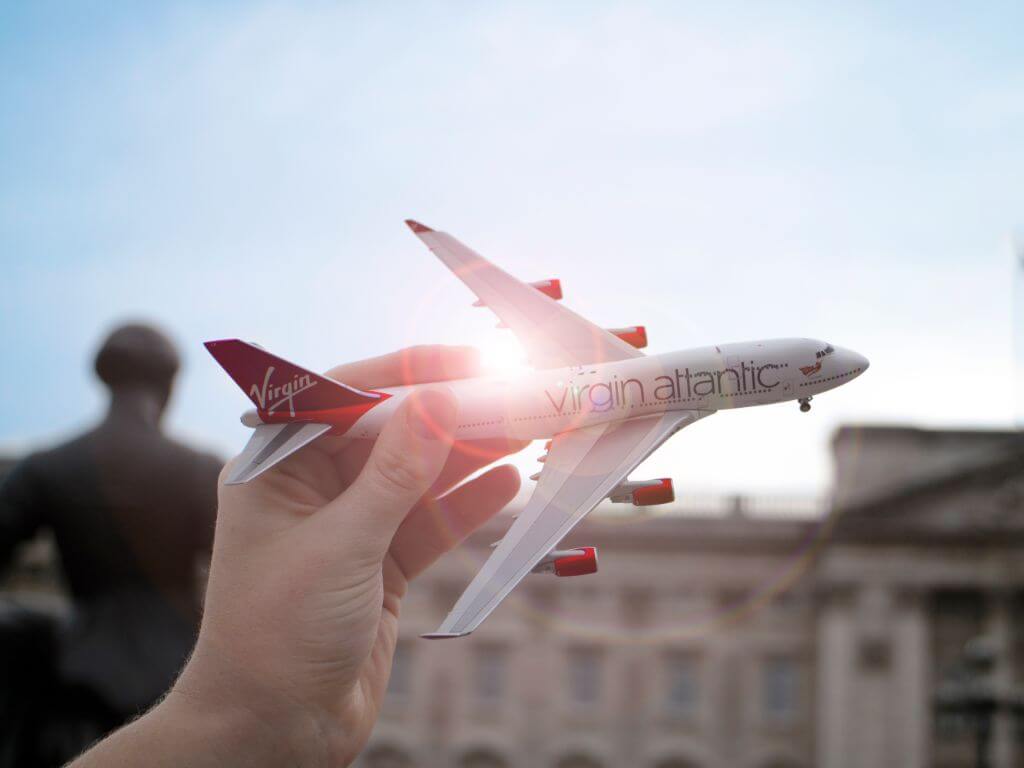
Helpful tips
.png)
Enable JavaScript
Please enable JavaScript to fully experience this site. How to enable JavaScript
- Special assistance
Traveling with children
Traveling with children and infants.
We are committed to caring for people on life’s journey and want you and your children to have a safe and positive travel experience. To allow enough time for check-in, arrive early and be sure to have any required travel documents. You may have to present proof of age like a birth certificate for any children under the age of 18.
- Families with children under 2 years old can ask to board early at the gate.
- Only 1 carry-on diaper bag per child is allowed.
You can travel with a breast pump and small, soft-sided cooler of breast milk in addition to your carry-on or personal item. These items don’t have to be checked and are allowed even when you’re not traveling with a child. Also, most airports have nursing rooms and stations available for your convenience.
If you’re a family traveling with children under 15, we want to help make sure you’re seated together on your flight. Here are some tips for when you book:
- Be sure to book everyone in the same reservation.
- The farther in advance you book, the better. (Seats become limited closer to the day of travel.)
- On the seat map, choose seats for your entire family or skip seats for that flight.
- It’s better to skip seats than to choose just a few seats or seats scattered throughout the cabin. Our gate agents can try to reseat you but getting seats together the day of travel is difficult.
If you skip seats
If you’re unable to choose seats, don’t want to pay for seats, or chose a Basic Economy fare, our system will detect that you’re a family traveling. The system will search for seats together automatically before the day of departure. We’ll try our best to keep you together, but if seats are limited, we’ll assign seats so children under 15 are next to at least 1 adult.
Children and adults traveling in separate reservations
If you and your children are traveling together but have separate reservations, call Reservations so we can note it in each reservation.
Contact Reservations
Children 2 or older are required to have their own seat, a ticketed adult fare. Children under 5 can’t travel alone under any circumstances.
If you don't choose seats in Main Cabin or Basic Economy, we’ll assign seats a few days after you buy your tickets so children under 15 are next to at least 1 adult they’re traveling with.
We welcome infants as young as 2 days old, but infants under 7 days old must have a doctor's letter stating that they are medically cleared to travel.
Keep in mind:
- Only 1 infant may be seated in the lap of each ticketed accompanying adult and the infant must be included in the reservation.
- Additional infants under 2 years old must be ticketed and occupy an infant safety seat or in a separate aircraft seat.
- The infant must be under 2 years of age for the duration of the trip. If they turn 2 during a trip, they will need their own seat for the remainder of the trip.
Adding an infant to your trip
If you’re traveling within the U.S., including Puerto Rico, you can add an infant to your trip when you book on aa.com, or later once it is ticketed. You only need to contact Reservations if you’re traveling with an infant who is under 7 days old; or if you’re traveling outside of the U.S. (taxes and a percentage of the adult fare may apply on international trips).
Book a new trip
- Book your trip on aa.com
- Enter your information on the ‘Passenger details’ page
- Select ‘add infant in lap’
Book a trip
Update an existing trip
- Find your trip on aa.com
- Scroll to the ‘Passengers’ section
Find your trip
Call Reservations if:
- You’re traveling with an infant who is less than 7 days old
- You’re not traveling within the U.S., and Puerto Rico
Reserved seat
If your infant will travel in their own seat, you must buy a ticket. The infant must either travel in a safety seat approved by the Federal Aviation Administration (FAA) or be able to sit upright in their seat without assistance and have their seatbelt securely fastened during taxi, takeoff, landing and whenever the 'fasten seatbelt' sign is on.
Bassinets and changing tables
- Changing tables are available in the lavatories of all wide-body aircraft.
- Bassinets are available on a first come, first serve basis at the gate for travel only on 777-200, 777-300 and 787 aircraft.*
- Bassinets are not available in First / Business cabins.
*Infants using bassinets must be younger than 2 years old and weigh no more than 20lbs (9kg)
Acceptable safety seats
Most safety seats that are approved for use in motor vehicles are acceptable for use in aircraft. The seat must have a solid back and seat, restraint straps installed to securely hold the child and a label indicating approval for use on an aircraft.
The label may include:
- These notes: 'This child restraint system conforms to all Federal Motor Vehicle Safety Standards' and 'this restraint is certified for use in motor vehicles and aircrafts' or 'this restraint is certified for use in motor vehicles and aircraft.'
- Approval of a foreign government or a label showing that the seat was manufactured under the standards of the United Nations.
- The safety seat can't be used in an exit row or in the rows on either side of an exit row; window seats are preferred.
- Install the seat in the direction appropriate for the size of the child and according to the instructions on the label.
- The child must remain in the safety seat with the harness fastened during taxi, takeoff, landing and whenever the 'fasten seatbelt' sign is on.
- To carry on a safety seat, you must have bought a seat for the child, or a seat must be available next to you. If an unoccupied, adjoining seat is not available, the gate agent will check the safety seat to your final destination.
Review seat dimensions before your trip.
Safety seats are not allowed in First or Business on select planes due to the seat angles.
Airbus 321T
- Boeing 777-200
- Boeing 777-300
- Boeing 787-800
- Boeing 787-900
- Any device without an approval label
- Booster seats with no approval label or shoulder harness
- Vest and/or harness-type devices, except Aviation Child Safety Devices (ACSD) showing the FAA aircraft approval label
- Belt extensions that attach to the parent or the parent's restraint
- Any device that positions a child on the lap or chest of an adult
Carry-on and checked bags
If you’re flying internationally with an infant on your lap, we’ll issue the infant a ticket. You may check 1 bag for the infant at the same rate as the adult’s first checked bag.
- Each ticketed customer is allowed 1 stroller and 1 car seat to be checked free of charge
- Strollers over 20 lbs / 9 kgs must be checked at the ticket counter
- All other strollers should be checked at the gate before boarding
- If you have a stroller and a car seat only 1 can be checked at the gate
- Breast pumps and a small, soft-sided cooler of breast milk don’t count as your carry-on or personal item
- Play pens, wagons, cribs and 'pack and play' count as regular bags
- If any of these exceed carry-on limits they’ll be checked and incur regular fees
International documents
Children or infants traveling outside the U.S. are required to have the same documentation as an adult. If anyone under 18 is traveling internationally without both parents, they may be required to present a Letter of Consent.
International travel
Traveling during pregnancy
If your due date is within 4 weeks of your flight, you must provide a doctor’s certificate stating that you’ve been recently examined and you’re fit to fly.
Special assistance throughout your trip
For domestic flights under 5 hours, you won’t be permitted to travel within 7 days (before and after) your delivery date. If you need to travel within this time frame:
- Approval from your physician and a special assistance coordinator is required.
- Your physician will be required to fill out a passenger medical form before your flight. A special assistance coordinator will send the form directly to your physician.
Clearance from a special assistance coordinator is required for international travel or travel over water:
- Within 4 weeks of your due date (travel also requires a physician's note stating that you’ve been examined within the past 48 hours and you’re fit to fly)
- 7 days before or after your delivery (travel also requires a passenger medical form to be completed by your physician)
Flying on a partner airline?
Find helpful information if your trip includes 1 or more flights with our partner airlines.
- British Airways
- Japan Airlines
- Qatar Airways
Factor Review: I’m a Dietitian and Here Are My Thoughts
The meal delivery service can take the stress out of healthy eating.
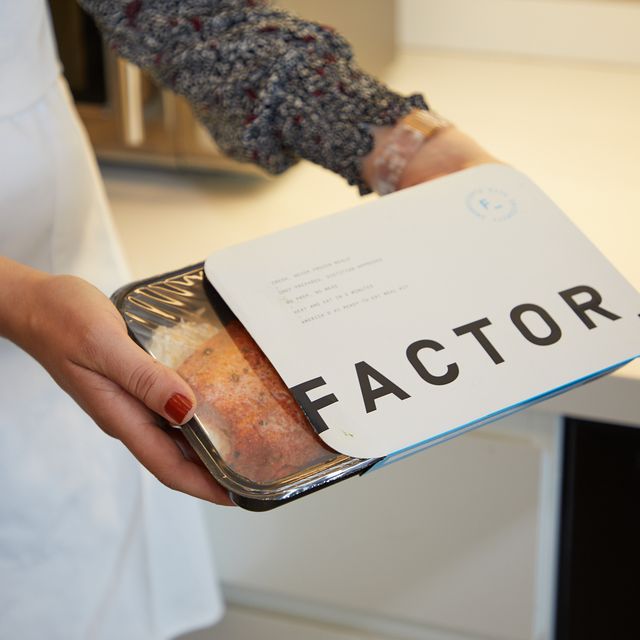
We've been independently researching and testing products for over 120 years. If you buy through our links, we may earn a commission. Learn more about our review process.
What is Factor?
How does factor work, meal choices, what does factor cost, nutrition and ingredients, my experience testing factor, who should order factor, is factor worth it, why trust good housekeeping, pros and cons.
- Variety of chef-crafted meals to choose from
- No prep or cooking required
- Easy-to-follow heating instructions
- Add-ons include smoothies, snacks and desserts
- Some meals are high in sodium
- Not ideal for larger families
Factor , also referred to as "Factor 75" or "Factor_" is a premier meal delivery service, offering freshly prepared dishes that arrive ready to heat and enjoy. According to Nick Wernimont, one of its co-founders, Factor was born out of a desire to give people more time in their day for moments to spend with family. With a dynamic weekly menu boasting 35 options prioritizing quality protein sources like chicken, beef, pork and seafood, Factor's meals are meticulously crafted by culinary experts and approved by registered dietitians, which was an added bonus for me.
Free from hormones, antibiotics and refined sugars, each dish promises a restaurant-quality experience (which I can attest to), catering to various eating patterns such as keto, vegetarian and high-protein diets. Differing from typical meal delivery subscriptions, Factor eliminates the need for any preparation or cooking; each meal arrives ready to be heated and savored, with minimal effort — what a dream. And if you find yourself unsure of which meals align with your unique needs or seek additional support to achieve your health and nutrition goals, Factor offers access to a team of registered dietitians available for virtual consultations.
Joining Factor is pretty straightforward, whether using the website or the app. After entering your email and zip code, simply pick a weekly meal plan, which can range from six to 18 meals. Then, explore the extensive menu featuring various chef-crafted dishes and add-ons like fruit smoothies and snacks to customize your order.
Deliveries are available on Saturday through Wednesday, depending on location. Modifications to orders can be made until the cut-off time, providing flexibility to match your lifestyle needs.
After your initial order, you'll then receive a weekly box of fresh meals, and you'll have the option to make changes until your cut-off time. Factor requires a week's notice to prepare meals fresh-to-order, ensuring quality ingredients and to avoid excess. The meals are delivered in insulated boxes with frozen gel packs to maintain freshness, and should be refrigerated upon arrival for optimal taste and quality, lasting up to seven days.
Though options are abundant in certain categories such as keto and high protein, others like dairy-free and vegetarian have fewer choices. Unfortunately, meal modifications aren't available currently. Each meal comes with detailed descriptions, ingredient lists and nutritional information in order to make informed decisions. Alongside ready-to-eat meals, Factor offers proteins, snacks, desserts and smoothies to enhance your order.
While there aren't specific meal plans offered, you can filter meals by different diet categories including:
- Chef’s Picks: A wide range of balanced, chef-made meals using wholesome ingredients to match any lifestyle
- Keto: Tasty, keto-friendly meals with about 15 grams or less of net carbs
- Calorie Smart: Portioned meals with roughly 550 calories or fewer per serving
- Flexitarian: Balanced meals focused on veggies and purposeful proteins for flexible eating habits
- Protein-plus: Satisfying meals loaded with 30 grams or more of protein to support your wellness goals
- Vegan & Veggie: Flavorful, meat-free meals for more plant-based eating options
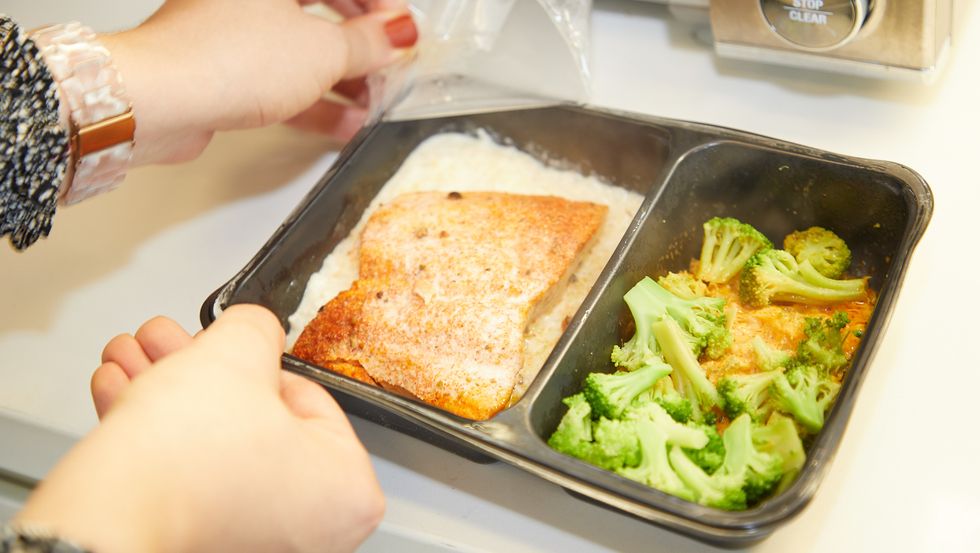
Factor offers a range of meal plans, from six to 18 servings per week, starting at $11 per serving. Choosing larger bundles, such as the 14- or 18-pack, provides greater value, particularly for those desiring daily meals. By opting for bigger orders, you can enjoy savings, reducing the cost per serving.
- 6-meal plan = $13.49 per serving
- 8-meal plan = $12.99 per serving
- 10-meal plan = $12.49 per serving
- 12-meal plan = $11.99 per serving
- 14-meal plan = $11.49 per serving
- 18-meal plan = $10.99 per serving
Factor meals typically range from 350 to 900 calories per meal, averaging around 600 calories. You can easily check the nutrition facts and ingredients for each meal by clicking on the meal images on Factor's menu page.
Also, if you are looking for assistance in choosing meals aligned with health goals, you can schedule a complimentary nutrition consultation with one of Factor's registered dietitians, which I thought was a nice touch, considering most meal delivery companies don't offer this. While low-sodium options are not available, you can check the sodium content of each meal by clicking on its photo.
Factor prioritizes quality ingredients and ethical sourcing, collaborating closely with food purveyors and animal welfare experts. The company shares its U.S. Chicken Welfare Policy for transparency regarding its standards and future goals. One tester said, “I like that it is free of preservatives, and uses mindfully sourced meats and eggs.”
Detailed nutritional information for each meal is accessible on Factor's menu, and allergen information is provided on the website and meal sleeves. Since Factor cannot accommodate all dietary preferences, customers are encouraged to review ingredients before ordering to ensure they meet their dietary needs.
Ordering and meal selection
I was happy that I could easily check the menu before choosing a meal. Being a food enthusiast, I was attracted to the stunning images of gourmet dishes. Factor's dishes felt like an upgraded version of microwave meals. I'm not a fan of microwaveable meals, which all too often suffer from uneven cooking and mushy or rubbery vegetables and meat. I was prepared for the worst, but very hopeful at the same time.
When deciding on my meal plan, I chose the Flexitarian option to enjoy meals containing both animal- and plant-based proteins, along with plenty of vegetables to keep me satisfied and maintain my energy level. Despite my shellfish allergy and lactose intolerance, the wide array of meal choices allowed me to select without any restrictions. I typically strive for a well-rounded combination of protein, carbohydrates and veggies in each meal, and Factor's offerings exceeded my expectations in providing nutrient-rich, balanced options.
Once I settled on my preferred plan, I carefully selected six meals for my delivery, a very challenging decision. Here's what I ordered:
- Goat Cheese Filet Mignon
- Creamed Spinach and Bacon Chicken
- Cilantro Lime Barramundi
- Baja Salmon with Cauliflower Rice
- Baja Tofu Black Beans and Rice
- Roasted Veggie Pesto Tortellini
The final step involved choosing my delivery date and eagerly anticipating the arrival of my Factor box.
Unboxing the meals
When the box arrived, it was in good condition, and all the ingredients were cool and fresh, thanks to the insulated packaging. Everything inside was well-organized, and the meals looked vibrant and high-quality. I also liked that the packaging was mostly eco-friendly, with options for recycling, reusing or composting.
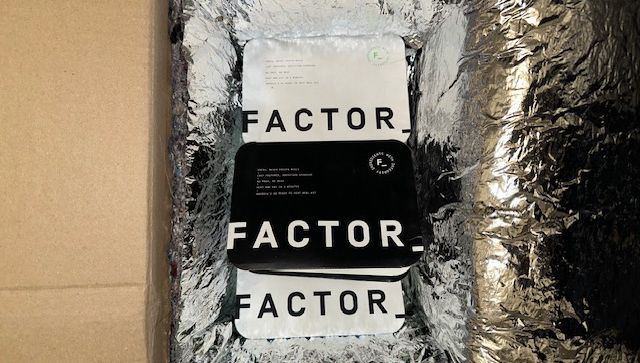
Prep and cooking
The best part? No prep, no cooking — just a quick poke with a fork to ensure proper heating, then straight into the microwave, which is exactly what I did. Alternatively, the Factor team highly recommends that you can heat meals on a sheet pan in a standard oven. One tester loved the simplicity of it all and commented, “It was easy to heat up the food — two minutes in the microwave, and the meals maintained pleasant flavor, texture and overall freshness.”
I noticed that each meal came with specific heating instructions on the packaging so I felt very confident during this process. All meals have to be fully heated to safe internal temperatures of 165° Fahrenheit. While I made sure I met that requirement, I found that one of the meals, the Filet Mignon needed an extra 30 seconds in the microwave to ensure it was warmed evenly. It's crucial to make sure all parts of the meal are heated properly to avoid any risk of food borne illness. Also, just an FYI, the meal trays are not suitable for convection or toaster oven use. Overall, the instructions were clear and easy to follow, which kept the process moving quick for me since I had a long day of to-do's.
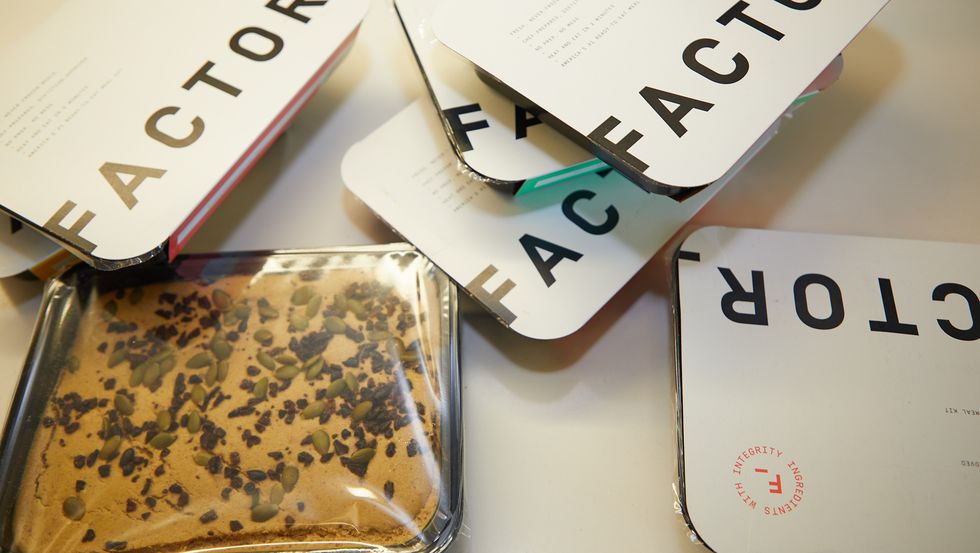
Taste and nutrition
The meals were rich in flavor, showcasing thoughtful recipe development with the use of herbs and spices, which was a highlight for me compared to other pre-made options I've tried. The serving sizes were generous, providing ample portions which I found satisfying. The Cilantro Lime Barramundi stood out as a favorite to me and the testers.
After trying the Salmon and Barramundi, one GH tester noted, “I liked the flavor of the main course as well as the overall portion size. The fish seemed like it was very good quality with nice consistency and meatiness. I also liked that the food wasn't watery.”
One of the downsides was the mushiness of some of the sides. Several testers in the Lab tried the vegetarian and vegan meal options. After trying the Baja Tofu Black Beans and Rice, a vegan option, one tester commented, “While I didn't mind the chewiness, the tofu and rice did feel a tad on the soggy side.” Another tester added, “I didn't love that the tofu was somewhat chewy. I think with the spicy flavors, it would have tasted better crispy. I also felt that the portion was a bit small for dinner because I eat a decent amount of food after working out.”
The second dish, Roasted Veggie Pesto Tortellini, was vegetarian. The pesto on the tortellini had a remarkably fresh taste, surpassing some jarred versions I’ve tried. The tortellini itself was cooked perfectly, boasting delightful flavor and texture. However, it lacked sufficient protein, which was a concern for one tester who follows a vegetarian diet and prefers protein-rich meals. They noted, “It did not have a ton of sources of protein, so it's not something I'd look for in a pre-made meal since pasta is a pretty simple dish to make myself.” I wasn't a big fan of the Filet Mignon since the texture was a bit tough for my liking, but the sides (cheesy grits and roasted carrots) were very flavorful.
One drawback of the meals was their higher sodium content — ranging from 800–1200 mg — making them less suitable for individuals with heart or kidney concerns or individuals at risk. It would be great for Factor to explore developing lower-sodium meal options while still allowing customization with salt to suit individual preferences.
While I appreciated the overall convenience, I wished the company provided recipe cards so I could recreate some dishes at home, particularly the Barramundi as I am always looking for new ways to prepare and enjoy fish. Despite this, the meals were of excellent quality, meeting my flavor expectations. I look forward to trying more recipes, especially during extremely busy weeks.
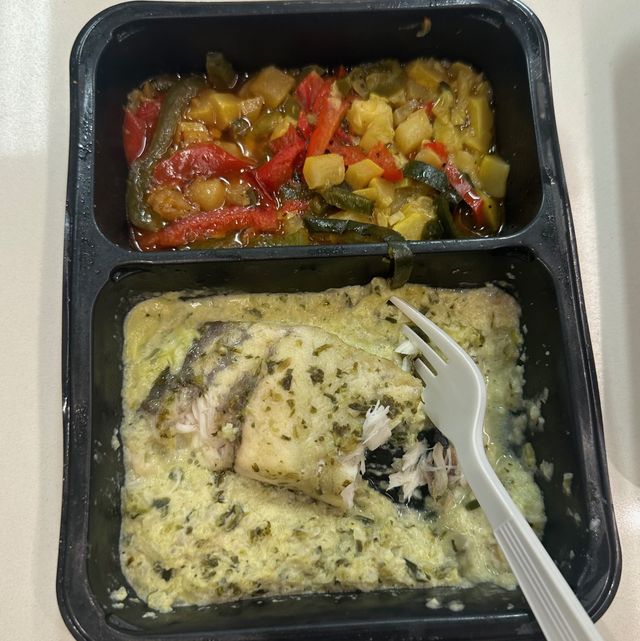
Factor is perfect for busy individuals or couples who want to eat healthily without the hassle of cooking. It's also a fantastic option for those following specific eating patterns like low-carb, keto or high-protein diets, whether you're physically active or just starting your wellness journey and need a little support.
However, Factor isn't ideal for those who are on a tight budget, have families or have a lot of dietary restrictions and needs. While it's not specifically a meal delivery service for weight loss , Factor's meals can support your unique health goals and the company offers complimentary nutrition consultations with registered dietitians, an added bonus compared to other healthy meal delivery services . Factor also integrates their platform with popular nutrition tracking apps like MyFitnessPal for your convenience.
Absolutely. Factor is a top-notch meal delivery service offering freshly prepared dishes ready to heat and enjoy. With a diverse weekly menu of 35 chef-crafted options emphasizing quality protein sources like chicken, beef, pork, and seafood, Factor caters to various dietary preferences, including keto, high-protein, vegetarian, and more.
While there are some drawbacks, notably the higher sodium content, the convenience and quality of Factor meals make it worthwhile. The service is a bit on the pricier side, with one GH tester who noted, “It's way too expensive for me to ever consider buying it myself.” If you're able to budget for these meals, then it might be worth exploring.
Also keep in mind the meals come prepared, likely one of the reasons why it's a bit on the pricier side. Another tester said, “I've always been overwhelmed by which meal delivery service to choose, but I definitely will be ordering Factor for my husband and me. I really appreciate the quality of the meals and how well-balanced they are.”
Having meals delivered eliminates grocery shopping and meal-prep hassle, and the nutrient-packed, delicious dishes are easy to enjoy with minimal effort. Plus, Factor provides access to registered dietitians for personalized support. Overall, Factor is a fantastic solution for busy individuals looking for nutritious, convenient meal options.
At the Good Housekeeping Institute , we test all different types of food products and services. From healthy snacks and supplements to food subscription boxes and meal delivery services, our experts are committed to bringing you the best of the best when it comes to quality, performance, flavor, nutrition and more. In our most recent study of meal delivery services, we recruited over 300 home cooks across the nation, while our in-house experts also tested the services in our Labs. All in all, we evaluated over 50 different meal delivery services, ranging from traditional kits that come with pre-measured ingredients and a follow-along recipe card to fully prepared options. We tested the services over the course of three months in the categories of overall satisfaction, food quality, cost, recycling efforts and availability.
Valerie Agyeman is a women's health dietitian and the host of the Flourish Heights podcast, where she produces science-driven content covering overlooked nutrition, wellness and women’s health topics. She has over 10 years of nutrition communications, corporate wellness and clinical nutrition experience. Agyeman is a trusted expert and regularly appears on networks including ABC’s Good Morning Washington , and she is a contributing expert to publications like Women’s Health , The Thirty and Shape .

Valerie Agyeman (she/her) is a women's health dietitian and the host of the Flourish Heights podcast, where she produces science-driven content covering overlooked nutrition, wellness and women’s health topics. She has over 10 years of nutrition communications, corporate wellness and clinical nutrition experience. Valerie is a trusted expert and regularly appears on networks including ABC’s Good Morning Washington , and she is a contributing expert to publications like Women’s Health , The Thirty and Shape .
@media(max-width: 64rem){.css-o9j0dn:before{margin-bottom:0.5rem;margin-right:0.625rem;color:#ffffff;width:1.25rem;bottom:-0.2rem;height:1.25rem;content:'_';display:inline-block;position:relative;line-height:1;background-repeat:no-repeat;}.loaded .css-o9j0dn:before{background-image:url(/_assets/design-tokens/goodhousekeeping/static/images/Clover.5c7a1a0.svg);}}@media(min-width: 48rem){.loaded .css-o9j0dn:before{background-image:url(/_assets/design-tokens/goodhousekeeping/static/images/Clover.5c7a1a0.svg);}} Product Reviews
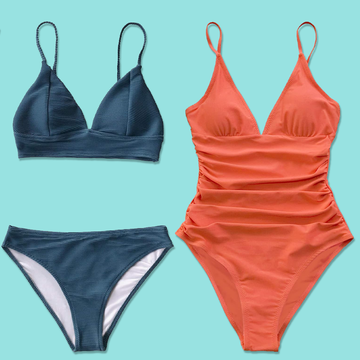
The Best Window Air Conditioners for Your Home
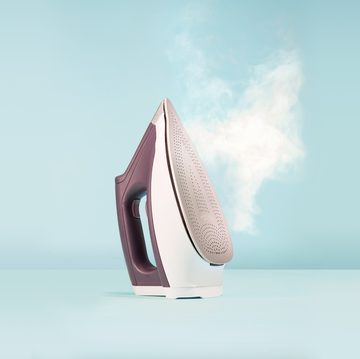
The Best Irons for Clothes
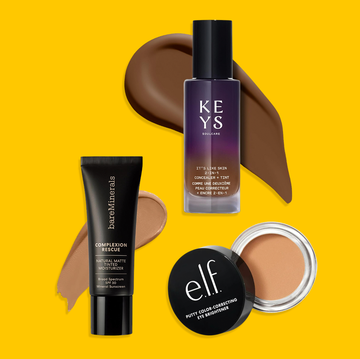
Everything You Need to Know About Makeup for Men

Wonderskin Wonder Blading Lip Stain Masque Review
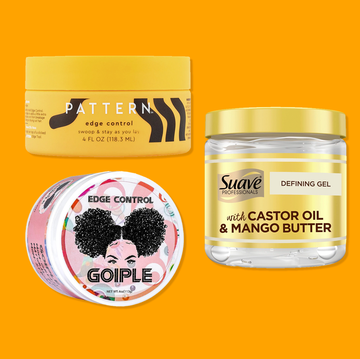
The Best Edge Control Products

The Best Mattress for Sex
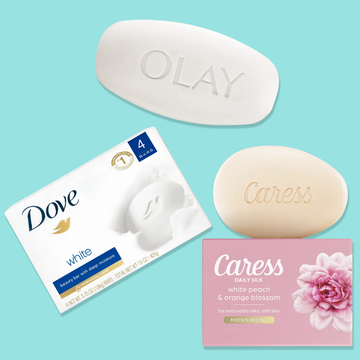
The 10 Best Bar Soaps

The Best Gifts for 7-Year-Old Girls
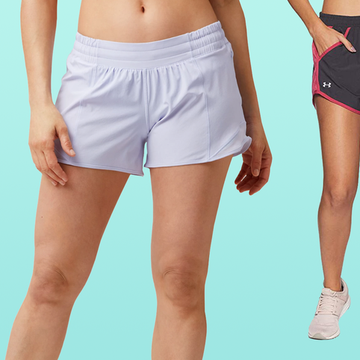
The Best Running Shorts for Women
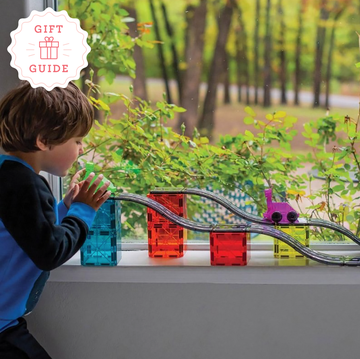
The Best Gifts for 6-Year-Old Boys
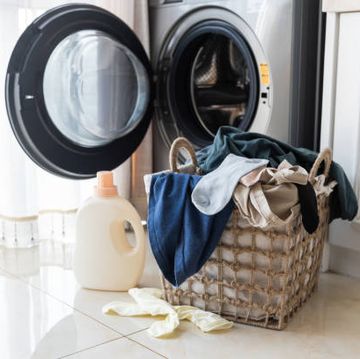
The Best Washer and Dryer Combos

IMAGES
VIDEO
COMMENTS
If it is in your hand luggage and it is for your baby on the flight, then it is NOT subject to the 100ml/3-1-1 liquid rule set by individual countries. This includes water, breast milk, powdered milk, baby food pouches and jars. TSA state, "Baby food is allowed in reasonable quantities in carry-on bags.
The final decision rests with the TSA officer on whether an item is allowed through the checkpoint. Baby food is allowed in reasonable quantities in carry-on bags. Remove these items from your carry-on bag to be screened separately from the rest of your belongings. Please see traveling with children for more information.
Pack your formula, breast milk or juice in TSA pouches. When you arrive at TSA with your carry-on full of baby food, be sure to inform the TSA agent that you are traveling with the food before you begin your screening process. TSA will ask you to take these items out of your bag and will screen them through a separate process.
Most importantly, while traveling keep your baby hydrated by offering breast milk or formula. Even if your baby is eating less solid food than at home, you'll know your baby is still getting the important nutrients they need. 10. Follow Baby Food Safety. Make sure you have access to a fridge for any leftover baby food.
You may also be starting solid foods with your baby, so you'll need to think about managing baby food while traveling. My son in San Diego at 6 months old. Traveling with a 9-month-old Baby. At nine months, babies are usually on a regular sleep schedule, but can also fall into some sleep regressions which can make sleep an issue. Your baby is ...
TSA officers will consult parents or the traveling guardian about the child's screening. TSA standard screening procedures apply for children 13 years and older. Carry-on property of all passengers, regardless of age, must be screened. ... Formula, breast milk, toddler drinks and baby/toddler food (to include puree pouches) in quantities ...
Wipes, lots of them. A changing pad. Diaper cream (no more than 3.4 ounces if you're flying by plane) Two bibs. Three baby blankets that you can use as burp cloths or to cover yourself up with while breastfeeding. Two bottles (if you use them) Change of clothes for your baby.
The TSA classifies baby formula as medically necessary, so you can pack as much baby formula as you need for the trip without being limited to the 3.4-ounce rule that applies to other liquids. When you go through security screening, inform airport security of the amount of baby formula you're carrying. Remove the formula from your carry-on so ...
A basic first aid kit. Small toy (s). The rest of your baby's items, like additional clothing, blankets and more, can go in your checked bag. If you're checking more than one bag, split your baby's items among different checked suitcases. That way you'll be covered if the airline loses one of your suitcases.
The TSA allows parents to bring baby essentials such as bottles (including breast milk and formula), baby food (including puree pouches) and medication through security, even if they're over 3.4 fluid ounces—and they don't need to be in a quart-sized bag with the rest of your liquids, they just need to be in your carry-on.
Whether traveling with your infant, older baby, or toddler by car or plane, double-check any car seats you use for safety. Look up the expiration date to make sure the seat hasn't expired, and ensure that it's properly installed. 9. Keep Feedings and Sleep Schedules Consistent.
Travel gear. To get your baby from point A to point B, you'll need a few basics. Travel stroller. If you're running late to catch a flight, it's much easier to push your baby in a lightweight umbrella stroller than to carry them through a long terminal. Some travel strollers are Federal Aviation Administration (FAA)-approved and fold to fit in the carry-on bins on board, but most get gate-checked.
A passport for international flights. All U.S. citizens, including newborns, need their own passports to fly internationally. To obtain one for your baby, you'll need to use the DS-11 form and apply together in person, so plan ahead. For domestic flights, babies and children under 18 don't need a passport or an ID. Her birth certificate.
Baby Pancakes (only 3 ingredients!) Ok, this one involves some cooking, but I swear it's easy! Mix together 1 ripe banana, 2 eggs, and 1 1/2 teaspoons of coconut oil. Scoop batter into a skillet and cook on low-medium heat until lightly brown, flipping once when you can see bubbles along the outer edge.
Review airline and TSA food rules if flying. Pack water in a water bottle to keep the kids hydrated. For adults, some easy travel foods or road trip foods can include almonds, Greek yogurt, beef jerky, nut butters in pouches, carrot and celery sticks, dark chocolate, chips, turkey and cheese, and more.
Any baby food or milk you are taking on the flight may need to be tested before it is allowed through security. This will usually be done by asking you to taste it yourself. If you are unwilling to do this, it is unlikely you will be permitted to travel. Remember to book your airport parking, airport hotels and airport lounges with ...
Bottles/nipples, soap, and a bottle brush: If your baby drinks formula or pumped milk, you'll want to bring along at least a couple of bottles. Resist packing too many though, because they'll take up way too much space and you'll rarely need more than 2. You'll just need to wash each bottle right after you use it!
Opt for cooked and suitable meals. Prioritize the well-being of your little one by following travel foods for babies. 2. Along with raw foods, you should also avoid dishes with raw ingredients like mayonnaise, souffle, sushi etc. 3. Always try to go for steamed foods - steamed rice, steamed idlis and cooked vegetables.
Packing a Travel Diaper Bag. Bottles, baby food, diaper cream and drool bibs! Each evening when you return from outings, empty and refill the diaper bag. Reload the bag with wipes and diapers, clothing changes and baby food. Taking time to restock at night will allow for less stress in the mornings.
3 / 8. "Invest in a backpack with a number of dividers," says Christian. "This is the best way to keep your hands free to cuddle your baby until you are seated on board.". Babies come with a lot of baggage so it's important to check what you can and can't take on the plane. You can bring: a reasonable amount of baby milk - breast ...
Appetizers—hummus and pita, edamame, chicken satay, sweet potato fries—can help keep the little one occupied and happy. And often they make great meals for the kids too. Playing with straws, in addition to drinking from them, can also help pass the time, as well as books, crayons, and washi tape. TIP: Devices are fine in restaurants, but ...
Travelling with an infant on your lap - You can request a pureed baby meal (suitable up to 12 months old) via My Booking. We only offer a baby meal, so if your little one has moved on to solid food please bring something along with you for them to eat. Travelling with an infant in their own seat - You can request a baby meal or a child meal.
To allow enough time for check-in, arrive early and be sure to have any required travel documents. You may have to present proof of age like a birth certificate for any children under the age of 18. Families with children under 2 years old can ask to board early at the gate. Only 1 carry-on diaper bag per child is allowed.
What does Factor cost? Factor offers a range of meal plans, from six to 18 servings per week, starting at $11 per serving. Choosing larger bundles, such as the 14- or 18-pack, provides greater ...